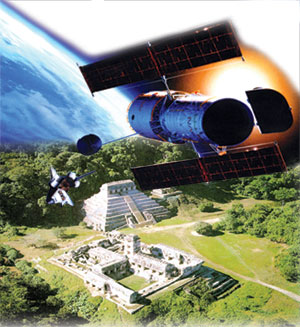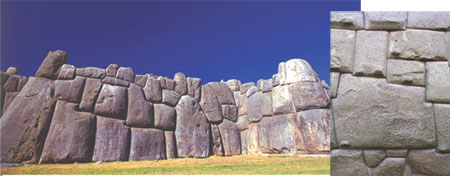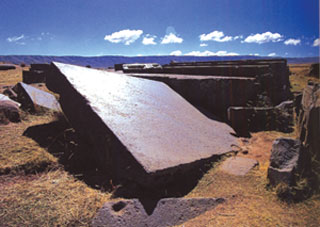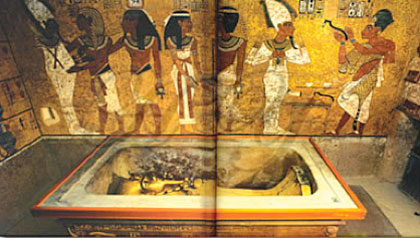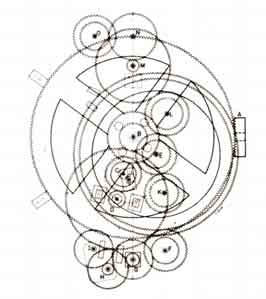Astonishing Remains of Ancient Civilizations
The erroneous concept of socio-cultural evolution was proposed at different times by such ideologues as August Comte, Herbert Spencer and Lewis Henry Morgan—and later combined with Charles Darwin's theory—stating that all societies evolve from the primitive towards complex civilization. This error, developed in the late 19th century and whose influence increased in the period following World War I, supplied a supposedly "scientific" basis for racism, colonialism, and the ruthless movement of eugenics. Societies in different parts of the world with different cultures, skin colors and physical features were subjected to inhuman treatment inspired by this unscientific preconception.

| |
Today, alongside highly advanced civilizations, there are also rather backward ones. However,
that some societies are more advanced technologically does not mean that they are more mentally
or physically developed.
|
Writers and thinkers like Adam Ferguson, John Millar and Adam Smith suggested that all societies evolve through four basic stages: hunting and gathering, pastoralism and nomadism, agriculture and finally, commerce. According to evolutionists' claims, primitive men who had just diverged from the apes only hunted and collected plants and fruits with the simplest of tools. As their intelligence and abilities gradually increased, they began domesticating grazing animals like sheep and cattle. Their intelligence and abilities eventually developed to the point of being able to engage in agriculture, and at last, to engage in trade and exchange of goods.
However, advances and recent discoveries in archaeology, anthropology, and other branches of science have invalidated this basic claim of the tale of "cultural and social evolution." These are nothing more than materialists' attempts to portray Man as having evolved from unreasoning beasts and to impose this myth—in which they believe for philosophical reasons—on science.
That humans could survive by hunting or agriculture does not show that they were either more backward or more advanced mentally. In other words, no society engages in hunting because it is backward and mentally closer to apes. Engaging in agriculture does not mean that a society has distanced itself from being primitive. No society's activities imply that its inhabitants are descended from other living things. Such activities do not produce, through any alleged evolutionary process, individuals who are more advanced in terms of intelligence and ability. Many of today's technologically backward tribes engage solely in hunting and gathering, but this definitely does not suggest that they are any less than human. The same will apply to humans living tens of thousands of years in the future, just as it did to those living hundreds of thousands of years ago. The latter were not primitive humans, nor will those in the future be a more advanced species.
Constructing an evolutionary history of civilization based on societies' lifestyles is an unscientific approach. This perspective rests on interpreting various archaeological findings according to scientists' materialist prejudices, which assume that those humans who used stone tools were ape-men who grunted, stooped over with their knees bent, and exhibited animal-like behavior. Yet no remains discovered provide any clue regarding these people's mental capacities. This is all mere conjecture. As already stated, if various examples of today's art are discovered in 100,000 years' time and if the people of the future lack any further information, then they will likely produce very different interpretations of today's humanity and the technology we possess.
As we've shown, the idea that societies evolve is based on no scientific evidence whatsoever. This theory's foundation is the mistaken, unscientific view that Man originally possessed an ape-like mind. The Harvard university evolutionist anthropologist William Howells admits that the theory of evolution raises other questions, not about the body but about behavior that are to do with philosophy, determining the scientific facts about which is far more difficult. Howells points out that behavior is not "fossilized" in the sense that a skull may be and that it does not survive like stone tools. Therefore, he says, we have only very slight clues as to what might have happened in the ancient past. He also notes that it is just about impossible for such hypotheses to be tested. 36
Recently, indeed, the majority of social scientists have admitted the errors in the evolutionist view, stating that the social-evolution theory conflicts with science on the following points:
1. It is closely linked to ethnic discrimination, making biased interpretations of different societies—for example, on the assumption that Western societies are more civilized.
2. It suggests that all societies progress along the same path, using the same methods, and share the same objectives.
3. It views the society from a materialistic perspective.
4. It is largely incompatible with findings. Many communities living under primitive conditions possess more civilized spiritual values than various communities regarded as modern—in other words they are peace-loving and favor equality. Because of their diets, many are also healthier and stronger.
As these points clearly show, the conception that societies progress from the primitive to the civilized is incompatible with the scientific values and facts. This theory is based on interpretations distorted under the influence of materialist ideology. The remains and artifacts that past civilizations left behind reveal the errors in the "evolution of history and culture" deception.
|
|

|
|
That people survive through hunting or agriculture does not mean that they are any more advanced or backward in terms of their mental abilities. In other words, a society that survives through hunting does not do so because it is supposedly closely allied to the apes. Nor a society's engagement in agriculture means that it has moved a long way on from apes.
|
No such primitive creatures such as are shown in this drawing ever existed. This and similar images are the work of the imaginations of Darwinist scientists, and are of no scientific value.
|
Traces of The Past Refute Evolution
Findings from past civilizations invalidate the theory of "progress from the primitive to the civilized." When we examine the course of history, the truth that emerges is that humans have always enjoyed the same intelligence and creativity. The works produced by people hundreds of thousands of years ago, and the traces they've left behind, actually have very different meanings than what evolutionists claim. When we look at these same traces we see that people in all past ages, with their intelligence and capacities, have made new discoveries, met their needs and constructed civilizations.
The messengers sent helped their people develop and progress by way of initiating major changes. Inspired by God, they possessed detailed scientific knowledge. For example, Prophet Noah (pbuh) knew boat-building technology, for we understand from the Qur'an that his ark was steam-powered (God knows the truth):
So when Our command came and the oven gushed forth water, We said: "Load into it [the ark] a pair of every species, and your family – except those against whom the Word was preordained – and all who believe." But those who believed with him were only few. (Qur'an, 11:40)
Such an oven, known as tannur, is still used today in various regions. It is related in the verse that this oven gushed forth water. Thus, the ark was readied for movement by the stove's bubbling or, in other words, by the stove boiling. Indeed, in his commentary, Hamdi Yazir of Elmali says that the ark was "a kind of steamship powered by a stove":
Tannur: Described in the dictionary as a closed oven or stove. The word "fara" means boiling and spurting with great force and intensity. . . . In other words, it implies that the boat is not a sail-powered one, but is reminiscent of a steamer powered by a stove. 37
Major advances in science, art, and technology were made also in the time of Prophet Solomon (pbuh). The Qur'an indicates, for instance, that transport vehicles as fast as airplanes were used in his day: " And We gave Solomon power over the wind – a month's journey in the morning and a month in the afternoon" (Qur'an, 34:12).
This verse clearly indicates that long distances could be traversed quickly. This points to wind vehicles that used a technology similar to that employed in our own day. (God knows the truth.) Moreover, the Qur'an reports that:
They made for him anything he wished: high arches and statues, huge dishes like cisterns, great built-in cooking vats. "Work, O family of David, in thankfulness!" But very few of My servants are thankful. (Qur'an, 34:13)
In other words, Prophet Solomon (pbuh) caused his workers to employ very advanced construction and architectural technologies.
Another verse states that:
. . . And the demons, every builder and diver. (Qur'an, 38:36-37)
The fact that Prophet Solomon (pbuh) could control diver demons indicates the location and extraction of undersea resources. Undersea oil and precious metal extraction processes and work require a highly advanced technology. These verses emphasize that such technology both existed and was used.
Another verse describes "a fount of molten copper" (Qur'an, 34:12). The use of molten copper indicates the existence of an advanced technology using electricity in Prophet Solomon's (pbuh) time. As we know, copper is one of the best conductors of metal and heat, for which reason it represents the basis of the electricity industry. The term, "We made a fount of molten copper flow" in all probability points to large quantities of electricity being produced and used in many technological fields. (God knows the truth.)
Several verses reveal that Prophet David (pbuh) had a good knowledge of ironworking and making armor:
And We made iron malleable for him: " Make full-length coats of mail, measuring the links with care. And act rightly, all of you, for I see what you do." (Qur'an, 34:10-11)
The Qur'an also mentions that Dhu'l-Qarnayn (pbuh) constructed a barrier between two mountains that could not be crossed or tunneled through by the societies of the time. According to the relevant verse, he used ingots of iron and molten copper:
[Dhu'l-Qarnayn said:] "Bring me ingots of iron!" Then, when he had made it level between the two high mountain-sides, he said: "Blow!" and when he had made it a red hot fire, he said: "Bring me molten copper to pour over it." (Qur'an, 18:96)
This information indicates that Dhu'l-Qarnayn used reinforced concrete technology. Iron, one of the strongest materials used in construction, is essential for increasing the strength of such architectural works as buildings, bridges, and dams. It appears from this verse that he laid the iron end to end and made a strong reinforced concrete structure by pouring mortar over it. (God knows the truth.)
Inscriptions from ancient Central American civilizations refer to a tall, bearded person arriving wearing white robes. They also report that within a short space of time, belief in a single deity spread and a sudden leap forward in art and science occurred.
Many prophets, such as Jacob, Joseph, Moses, and Aaron (peace be upon them all) were sent to ancient Egypt. These messengers and the people who believed in them may have had an important influence on the rapid artistic and scientific progress made by Egypt at various times.
Muslim scientists following the Qur'an and the Sunnah of our Prophet (may God bless him and grant him peace) made important discoveries in astronomy, mathematics, geometry, medicine, and other sciences. These made major change and significant progress possible in science and social life. Some of these Muslim scientists and their work are as follows:
Abd al-Latif al-Baghdadi is known for his work on anatomy. He rectified previous errors concerning many of the body's bones, such as the lower jaw and the breastbone. His Al-Ifada wa al-I'tibar was set out in 1788 and translated into Latin, German, and French. He studied the five sense organs in his Makalatun fial-Havas.
Ibn Sina (Avicenna) described the treatments for many diseases. His best-known work, Kitab al-Qanun fi at-Tibb, was written in Arabic and translated into Latin in the 12th century. It was taught and regarded as a basic textbook in European universities until the 17th century. Much of its medical information still applies today.
Zakaria al-Qazvini demolished many mistaken ideas regarding the brain and the heart that, since Aristotle's time, had been considered accurate. The information he provided about these two organs is very similar to our present-day knowledge.
Zakaria al-Qazvini, Hamd Allah Mustawfi Qazvini (1281-1350), and Ibn al-Nafis all studied anatomy and formed the foundation of modern medical science.
Ali ibn Isa wrote a three-volume work on eye diseases, Tadhkirat al-Kahhalin. The first volume is totally devoted to the eye's anatomy and contains much valuable information. It was later translated into Latin and German.
Al-Bayruni demonstrated, 600 years before Galileo, that Earth revolves and also calculated its diameter 700 years before Newton.
Ali Qushji studied the phases of the Moon, and wrote a book on the same subject. His studies became a guide for future generations.
Thabit ibn Qurra discovered differential calculus centuries before Newton.
The accuracy of al-Battani's astronomical observations amazed the succeeding scientists. He observed 533 stars, and correctly calculated the farthest distance of the Sun from the Earth . His studies and calculations on trigonometry made him a pioneer in mathematics.
Abu'l-Wafa was responsible for trigonometry acquiring the terms secant and cosecant.
Al-Khwarizmi wrote the first book on algebra.
In his book Tuhfat al-Ada, al-Maghribi showed methods to calculate the surface areas of geometrical figures, including triangles, quadrangles and circles.
Ibn al-Haytham is the founder of optics. Bacon and Kepler made use of his works, and Galileo used his works in his discovery of the telescope.
Al-Kindi put forward relativity and the theory of relativity 1,100 years before Einstein.
Akshamsaddin was the first to express the existence of microbes, 100 years before the Italian physician Fracastoro, who would be the first to introduce microbes.
With his book Kamil as-Sina'a at-Tibbiyya, Ali ibn Abbas al-Majusi was the pioneer of medical science, and his book was regarded as a fundamental book of reference in the treatment of many diseases.
Ibn al-Jazzar described the causes and treatment of leprosy.
Muslim scientists, only a minute fraction of whom are listed above, made major discoveries that would form the basis of modern science by following the Qur'an and the way of our Prophet (may God bless him and grant him peace).
As we have seen, many earlier peoples made progress in art, medicine, technology, and science through the messengers sent to them. By obeying the prophets and learning from these individuals' suggestions and encouragement, they acquired knowledge and handed this on to subsequent generations. In addition, societies that sometimes turned away from the true religion and developed superstitious beliefs returned to faith in the One God through these messengers' efforts.
When findings regarding past ages are looked at without prejudice, humanity's history can be understood very clearly and distinctly.
As already stated, backward and advanced civilizations have existed together at all periods in history, just as they do today. In our day, we enjoy space technology, while people in other parts of the globe are living under primitive conditions, so in the past Ancient Egypt had a glorious civilization on the one hand, while rather more backward societies existed in other parts of the world. The Mayans, who built highly developed cities, and who from the traces they left behind can be seen to have possessed a clearly advanced technology, calculated the orbit of the planet Venus and discovered the moons of the planet Jupiter. At the same time, people in many regions of Europe believed that the Earth was the center of the Solar System. While the Egyptians were successfully performing brain surgery, in other regions people believed that disease was caused by supposed evil spirits. With their legal system, literature, understanding of art and astronomical knowledge, the Sumerians built a deep-rooted civilization in Mesopotamia, while another corner of the world held societies that were still illiterate. Therefore, in the same way that today's civilizations are not all advanced, so in the past there was never a time when the only societies were backward ones.
So far, we have examined evidence belonging to different periods of history and reviewed examples of the cultures of tens or hundreds of thousands years ago. Looking at more recent history, again we encounter evidence that human beings have always been human: Here we are dealing not with "primitive" people who have only recently parted ways with apes, but civilized human beings who can be seen to have inherited yet another civilization that had persisted for thousands of years before them.
As technology advanced in the 20th century, archaeological research accelerated enormously, and began to unearth more and more evidence regarding the true history of mankind. Thus it emerged that life in Egypt, Central America, Mesopotamia and other regions thousands of years ago was in many ways parallel to how we live today.
Megaliths: Astonishing Artifacts from Human History
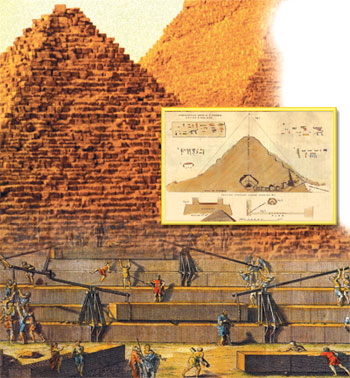
| |
The construction technique and technology employed on the pyramids are still a mystery. These giant works, whose construction would be hard to duplicate even using today's technology, were completed by highly competent people who lived over 2,500 years ago.
|
Megalith is the name given to monuments consisting of large blocks of stone. Many ancient megaliths have survived down to the present day. One of the most surprising aspects of these monuments is how such huge blocks of stone, some weighing more than a ton, were used to build the structures in question, how these stones were carried to their construction sites and by what techniques. How did the people of that time build these structures by placing one enormous block on top of another? These megaliths were generally built using stones brought from a long distance away, and are regarded today as marvels of construction and engineering. The peoples who produced such works must obviously have possessed some advanced technology.
First of all, of course, planning is essential in order to create these monuments, and those plans must be communicated accurately and fully to everyone involved in the project. Technical drawings of where the monument is to be erected have to be prepared. Moreover, the calculations in these drawings must be free of any error, because the slightest inaccuracy will make it impossible for the monument to be built. In addition, the organization involved must also be flawless if construction is to take place. Factors such as coordinating the workers and meeting their needs (for meals, rest, etc.) are vital to the progression of the construction in the desired manner.
Clearly, the people involved in constructing these monuments possessed an accumulated knowledge and a technology far superior to what is generally imagined. As mentioned earlier in this book, civilization does not always move in a forward direction; sometimes it regresses. And indeed, most of the time, both advanced and backward civilizations are able to exist simultaneously in different parts of the world.
It is exceedingly probable that the people who constructed the megaliths in question possessed an advanced civilization, as shown by the archaeological and historical remains. The structures they produced show that they had a wide-ranging knowledge of mathematics and geometry; that they knew the technology needed to build monuments by calculating fixed points in hilly areas; that they used equipment (such as the compass) to determine geographical positions, and that when necessary, they could transport the materials needed for construction from many kilometers away. Obviously, they did not manage all this by using only primitive tools and manpower. Indeed, many experiments by researchers and archaeologists have demonstrated that it would have been impossible to construct these monuments under the conditions proposed by the theory of evolution. Researchers who have attempted to construct similar monuments by reproducing the imaginary "Stone Age" conditions postulated by evolutionists have failed dismally. These researchers have not only found it difficult to construct any similar structure, but have also experienced enormous difficulties in transporting these stones from one place to another. This shows yet again that people of that era did not lead backward lives, as evolutionists would have us believe. They enjoyed and understood architecture, made expert use of construction technology and engaged in astronomical investigations.
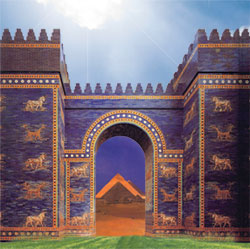
| |
The Ishtar Gate, Baghdad
|
It is perfectly understandable that only stone blocks, stone structures and various stone tools should remain from the civilizations of thousands of years ago. However, it is not logical to look at a handful of stone structures and artifacts and conclude that the people of that time had an undeveloped civilization completely lacking in any technology and was only able to use stone. Such assertions, based on various dogmas, are of no scientific significance. But if we evaluate these findings without the negative effects of preconceptions, then interpretations rather closer to the truth can be made. Even if a society of hundreds of thousands of years ago lived in impressive wooden houses, built beautiful villas with glass windows and used the most attractive decorative materials, obviously very little evidence of this would survive the erosive effects of the intervening centuries of wind, rain, earthquakes and floods. Under natural conditions, it takes only an average of 100 to 200 years for timber, glass, copper, bronze and various other metals to be worn away. In other words, in two centuries' time, the walls of your house will be worn away, and very little will remain of the furnishings inside. Even less will be left if it is subjected to earthquakes, floods or storms. All that will be left will be stone blocks that take much longer to be eroded away. Even then, stone materials will be worn away into smaller fragments. On the basis of these blocks of stone, therefore, it is impossible to make interpretations about the daily lives of societies of that time. Their social relationships, beliefs, tastes and artistic understanding cannot be deduced with any measure of certainty.
Yet evolutionists still attempt the impossible, adorning various discoveries with fictitious interpretations and inventing various scenarios. Producing fantasies by distorting the facts is something that is actually criticized by some evolutionists themselves! They have even given this approach the name of "Just So Stories."
That term appears in a criticism by the famous evolutionist paleontologist Stephen Jay Gould, which term he borrowed from the 1902 book of the same name by the British writer and poet Rudyard Kipling (1865-1936). In this book of tales intended for children, Kipling told a number of imaginative stories about how living things might have acquired their various organs and attributes. About the elephant's trunk, for example, he wrote this:
In the High and Far-Off Times the Elephant, O Best Beloved, had no trunk. He had only a blackish, bulgy nose . . . But there was one Elephant—a new Elephant, an Elephant's Child—who was full of satiable curiosity . . . So he went on . . .till he trod on what he thought was a log of wood at the very edge of the great grey-green, greasy Limpopo River, all set about with fever-trees. But it was really the Crocodile . . . Then the Elephant's Child put his head down close to the Crocodile's musky, tusky mouth, and the Crocodile caught him by his little nose . . . Then the Elephant's Child sat back on his little haunches, and pulled, and pulled, and pulled, and his nose began to stretch. And the Crocodile floundered into the water, making it all creamy with great sweeps of his tail, and he pulled, and pulled, and pulled. 38

| |
Rudyard Kipling's book, Just So Stories
|
Gould and certain other evolutionist scientists have criticized the literature for filling itself with similar scenarios, with no supporting evidence to back them up. The same applies to those who attempt to explain the development of societies in terms of the theory of evolution. Like Kipling's tales, the Just So Stories of evolutionist social scientists rely solely upon imagination. Indeed, consider a history of mankind based on societies whose supposed forerunners were only able to grunt and use crude stone tools, lived in caves, and survived by hunting and gathering, and who, as subsequently developed, began engaging in agriculture, and later began using metals, and began establishing social relationships as their mental powers increased. That "history" is no different from the story of how the elephant got its trunk.
Gould describes this unscientific approach:
Scientists know that these tales are stories; unfortunately, they are presented in the professional literature where they are taken too seriously and literally. Then they become "facts" and enter the popular literature. . . 39
In addition, Gould also states that these tales prove nothing in terms of the evolutionary theory:
These tales, in the "just-so story" tradition of evolutionary natural history, do not prove anything. But the weight of these, and many similar cases, wore down my faith in gradualism long ago. More inventive minds may yet save it, but concepts salvaged only by facile speculation do not appeal much to me. 40
Newgrange
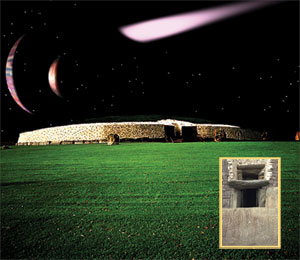
| |
117 Newgrange, one of world's best-known stone structures, consists of 93 megaliths.
|
This monumental grave near Dublin is agreed to have been built around 3,200 BCE. Newgrange was already old at a time before Egypt's civilization had come into existence, and before the birth of Babylonian and Cretan civilizations. Stonehenge, one of the most famous stone structures in the world, had not yet been built. Research has shown that Newgrange was not only a grave, but that its builders possessed a comprehensive knowledge of astronomy—and possessed engineering techniques and architectural knowledge worthy of emphasis.
A great many archaeologists describe Newgrange as a technical miracle. For example, the dome atop the structure is an engineering marvel all by itself. The single stones, heavy at the bottom and lighter on the upper parts, have been placed on top of one another so expertly that each one protrudes slightly from the one beneath it. From this, a hexagonal 6-meter-high chimney rises above the central part of the structure. On top of the chimney is a stone lid that can be opened or closed at will.
Obviously, this giant structure was built by people with an excellent understanding of engineering, able to calculate accurately, plan correctly, transport heavy loads of stone, and make good use of their construction know-how. Evolutionists can shed no light on how this structure was erected because, according to their unrealistic view, people of that time labored under primitive and backward conditions. But it's impossible for such an enormous monument to have been built by anyone lacking a sophisticated knowledge of engineering and construction.

| |
The entrance stone and the roof box at Newgrange. It is still not known how the blocks were transported, nor what techniques were employed during construction.
|
The structure's astronomical features alone are astonishing. This giant monument has been constructed in such a way that at winter solstice, it gives rise to an impressive light show. Shortly after daybreak on the shortest day of the year (December 21), a shaft of sunlight illuminates the Newgrange burial chamber. At this point, a perfect play of light occurs. Rays from the rising sun pass through a narrow opening on the bottom of the roof box over the entrance and shine down the passage to the inner chamber. All the stone blocks are placed at angles that allow the light to reach them and be reflected off them—one vital factor that makes this entire light show possible.
You can see, therefore, that the builders of this giant structure not only had a knowledge of engineering, but also possessed a knowledge of astronomy that let them calculate the length of days and the movements of the Sun.
Newgrange is just one of many stone structures of ancient times surviving in Britain. From looking at this structure, you can conclude that it was made by people with a deep accumulation of knowledge, using advanced techniques and methods. What interpretation can be made regarding the kind of lives those people led? The people who built such a structure may well have lived in comfortable, civilized surroundings. If they had a knowledge of astronomy and sufficient expertise to interpret those observations correctly, their daily lives must have been similarly civilized, in direct proportion to that accumulation of knowledge. This stone monument may be the only surviving building from a society that lived in comfortable homes, had well-maintained gardens, received treatment in good hospitals, engaged in commercial activity, regarded art and literature and enjoyed a broad, important cultural heritage. All these are realistic interpretations about the people who built this stone monument, based on the archaeological findings and the historical facts. Yet evolutionists, accustomed to thinking only along materialist lines, prefer to relate stories that are the product of specific dogmas, rather than make rational interpretations compatible with science. However, their stories can never express a definitive, true explanation.
Stonehenge

| |
Stonehenge may have been erected as the building blocks of a wooden construction. A wooden building erected on this would have been unaffected by wind and storms. It is likely that only the foundations of the building have survived. The methods and motives for the construction of Stonehenge are still a matter for debate, but one important feature revealed by scientists is its relationship with astronomy. The people who built this structure possessed an advanced knowledge of the heavens, as well as of engineering.
|
Stonehenge, a monument that stands in England, consists of some 30 large stone blocks arranged in a circle. Each of these blocks is an average of 4.5 meters (15 feet)high and weighs an average of 25 tons. The monument has attracted the attention of a great many researchers, and many theories have been proposed as to how and why it was erected. What matters here is not which (if any) of these theories is actually correct, but that this monument yet again invalidates the theory of "evolution" in the history of mankind.
Research reveals that Stonehenge was built in three main stages, beginning in about 2,800 BCE. In other words, the history of its construction goes back some 5,000 years. The initial stage of building included the digging of a ditch, bank and some round pits in the chalk. In the second stage, some 80 bluestones were set up in two rings around the center of the site and a heel stone was erected outside this. Later, an outer circle of giant sarsen stones was formed, with a continuous run of lintels.
One of the most noteworthy aspects of this monument is the bluestones used in it, because there are no sources of such stones anywhere nearby. These stones were imported to the site from the Preseli Mountains—some 380 kilometers (240 miles)away. If, as evolutionist historians claim, the people of that time lived under primitive conditions, with the only tools at their disposal being wooden cranks, timber rafts and stone axes, then how could they transport these stones all the way to the region where Stonehenge now stands? This question cannot be answered by scenarios that are mere figments of conjecture.
One group of researchers tried to transport bluestones as far as Stonehenge by reconstructing the equipment supposedly used at the time. To that end, they used wooden cranks, built a raft able to carry stones of an equivalent size by lashing three rafts together, moved the raft upriver using wooden poles, and then finally tried to move the stones uphill using crudely manufactured wheels. But their efforts were in vain. This was just one of the experiments carried out in order to establish how the bluestones might have been transported as far as where Stonehenge lies now. Many others have been performed, and investigators have attempted to understand what method of transportation the people of the time might have used. Yet none of these attempts came anywhere near achieving success, because they were all carried out under the misapprehension that the people who built Stonehenge had a backward culture and used only crude implements made of stone and wood.
Another point that needs emphasis is that the experiments in question benefited from present-day technology. They used various models produced in naval shipyards, employed ropes produced in high-tech factories, and made detailed plans and calculations. Yet even so, they obtained no positive results. However, people living some 5,000 years ago transported these stones, weighing many tons each, and arranged them in a circle by calculating their exact geographical positions. Clearly, they did not accomplish all this with stone tools, rafts made of logs and cranks made of timber. Stonehenge and the many other megaliths were built using some technology we are unable even to guess at today.
The Astonishing Remains in the City of Tiahuanaco

| |
It is impossible for stones weighing many tons each, used here in the South American city of Tiahuanaco, to be transported without steel cables, winches, and other construction equipment.
|
At about 4,000 meters (13,000 feet)above sea level, in the Andes Mountains between Bolivia and Peru, the city of Tiahuanaco is full of ruins that stun visitors. The region is regarded as one of the archaeological marvels of South America, indeed, of the entire world.
One of the most astonishing remains in Tiahuanaco is a calendar that shows the equinoxes, the seasons, and the position of the Moon at every hour and its motions. This calendar is one of the proofs that the people living there possessed a highly advanced technology. Among the other astonishing remains in Tiahuanaco are monuments made out of huge stone blocks, some of them weighing as much as 100 tons.
A Reader's Digest author wrote, "... the best engineers of today still ask themselves whether they could cut and move huge masses of rock such as those used to build the city. The giant blocks look almost as though a die were used to cut them..." 41
For example, the city walls were built by placing blocks weighing 60 tons on top of other blocks of sandstone weighing some 100 tons. The stoneworking used to build these walls required enormous expertise. Huge square blocks were joined together with accurate grooves. Holes 2.5 meters (8 feet)long have been opened in blocks weighing 10 tons. In some parts of the ruins, there are stone water conduits 1.8 meters (6 feet)long and half a meter (1.5 feet)wide. These are of a regularity which is seldom equaled even today. It's impossible for these people to have produced these works in the absence of technological means, in the way that evolutionists claim. That is because under the allegedly primitive conditions, it would take longer than a human lifespan to produce just one of these structures. That in turn would mean that it took centuries to create Tiahuanaco, which alone shows that the evolutionist thesis is false.
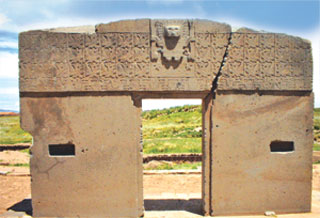
| |
The Gate of the Sun, estimated to weigh around 10 tons, could not have been built by a society devoid of technological means, as evolutionists claim. Such structures invalidate the evolutionist claim that human history evolved from the primitive to the developed.
|
One of the most noteworthy monuments in Tiahuanaco is the so-called Gate of the Sun. Made out of a single block, it is 3 meters (10 feet) high and 5 meters (16.5 feet) wide and is estimated to weigh more than 10 tons. The gate has been decorated with various carvings. No explanation can be given as to what methods were used to construct the gate. What kind of technology was employed in the building of such an impressive structure? How were blocks of stone weighing 10 tons extracted, and by what means were they transported from the stone quarries? It is clear that all these things were achieved using more than just simple tools and equipment, of the kind alleged by evolutionists.
When you also consider the geographical conditions of the region where Tiahuanaco stands, the whole feat assumes even more astonishing proportions. The city is many kilometers away from any normal settlement areas and stands on a high plateau some 4,000 meters (13,000 feet)high, where atmospheric pressure is around only half that at sea level. The greatly reduced oxygen level here would make tasks requiring a human workforce even more difficult.
All this goes to show that, as in many other regions of the world, advanced civilizations existed here in the past—which invalidates the thesis that the societies always "evolve" towards more advanced states.
Expert Stonemasons On Gobekli Tepe 11,000 Years Ago
| |
The stonework in the photos at bottom left and its detailed shapes display the artistic taste of the people who made them, 11,000 years ago. More important, however, is that the artists must have used metal tools to carve these stones, not by hitting or rubbing one stone against another. Such fine work is only possible by means of such tools, as the metal lathes, files and saws used in stonemasonry today.
The photo at bottom right shows a present-day stonemason at work, using similar techniques. Artists living 11,000 years ago may have produced their works of art only by employing similar methods.
|
Giant Building Blocks Weighing 20,000 Tons
| |
The ancient Incan city of Sacsahuamán near Cuzco in Peru contains a wall built using stone blocks weighing tons, each fitted so closely together that it's impossible to slide a piece of paper between them. In addition, no cement or mortar was used anywhere. The blocks have been placed together with the greatest expertise and precision. How these enormous blocks were shaped to fit so perfectly against one another has still not been unraveled using today's technology.
Even more astonishing, one stone block used in the construction is even larger than all the others. This block is the size of a five-story house and weighs some 20,000 tons! How the builders of Sacsahuamán managed to transport it is a mystery. Even with present-day machinery, it is impossible to lift such an amazingly heavy weight. Even the largest winch in the world today will find it hard to lift such a load. The Incas of that time in all likelihood used some technology we cannot even imagine.
|
Using Giant Stones In Construction Calls For Enormous Expertise
|
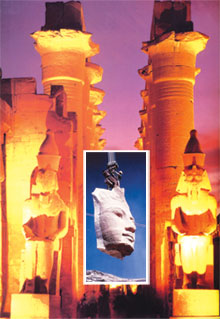
| |
The rows of pillars in Luxor were ordered to be built by Amenhotep III and were decorated by Tutankhamen.
|
Structures produced using stones weighing tens of thousands of tons still amaze people today. Moving such enormous stones can be done only using advanced construction equipment like winches and steel cables.
It is impossible to extract these stones from the quarries, much less transport them, set them in place or work them using such equipment as timber, logs, ropes and easily-broken copper tools, of the type evolutionists claim were used.
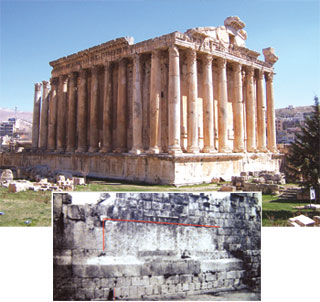
| |
Baalbek, Temple of Jupiter
|
The small picture in the middle shows how the head section of the massive Ramses statue could be transported only by using winches with steel cables.
Giant stone blocks were also used in the construction of this edifice, now known as the Temple of Jupiter. The stone block marked with red in the small photograph is one of three large blocks used in the retaining wall. Each of these three blocks is some 4.5 meters (15 feet) high, 3.5 meters (11 feet) wide and 19 meters (62 feet)long. Their average weight is around 800 tons. That such huge blocks were extracted and transported from their quarries suggests the advanced construction equipment that must have been used.
|
The Obelisks That Evolutionists Cannot Explain
|
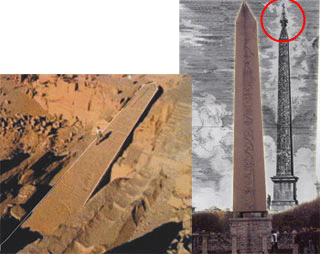
| |
An unfinished obelisk in a granite quarry near Aswan. This obelisk, twice the height of the others, is 41.75 meters (137 feet) tall and some 1,168 tons in weight. Advanced technology must have been used to extract this giant stone from the quarry and transport it to its destination.
|
The section assumed to have been on the top of the obelisk (as shown in red circle) may indicate that these standing stones were used as lightning rods.
|
Obelisks are one of the astonishing remains to have survived to our day from past civilizations. Some highly advanced technology must have been used to extract these upright stones, averaging 20 meters (65 feet)in length and weighing many tons, from the quarries, transport them, carve their surfaces and place them in upright positions. One of the oldest known of these large obelisks is that erected in Karnak, Egypt around 1,400 BCE. It stands 29.5 meters (97 feet) high, 1.62 meters (5.3 feet) wide and weighs 325 tons. Technical expertise and proper infrastructure are required to transport such a huge, heavy block from the quarry to its present location in a single piece. Tools of bronze and copper bend easily, and could not be used, so tools of iron and steel were obviously needed. This refutes the evolutionist claim that iron and similar metals were unknown at the time in question.
|
Discoveries In Puma Punku That Refute Evolution
| |
The size of the megaliths forming the ruins of the pyramid at the Puma Punku amazes visitors. One block in the step-pyramid, whose base measures approximately 60 meters (197 feet) by 50 meters (164 feet), weighs some 447 tons. The other stones used weigh between 100 and 200 tons. It is illogical to maintain, as evolutionists do, that these gigantic blocks were transported on logs using thick ropes.
Evolutionist archaeology can't explain the marks where a great many megaliths at the Puma Punku are joined together. These are reminiscent of metal clamps. For a long time it was thought that these T-shaped clamps had been pre-cast at a furnace, then placed cold into carved indentations in the blocks. Later investigations using scanning electron microscope, however, revealed that they were poured molten into the indentations. Spectrographic analysis showed that these clamps consisted of an alloy of 2.05% arsenic, 95.15% copper, 0.26% iron, 0.84% silicon and 1.70% nickel. All this is evidence that past societies used advanced equipment during the construction process. 42
|

| |
Imprint of metal clamp frequently encountered at the Puma Punku
|
Imprint of metal clamp seen on the blocks at Ollantaytambo
|
Imprint of metal clamp on stone structures at Angkor Wat, Cambodia
|
Ancient Egypt: A Magnificent Civilization in Terms of Art and Science
In one of the most magnificent civilizations in terms of art and science founded by humankind, the Ancient Egyptians possessed more knowledge and experience than could have been possible, had they been the "heirs" or continuation of some primitive society. Among the Egyptians, members of a deviant, pagan religion, there were Jewish workmen with a knowledge of art, which had its origins in the times of Prophets Noah and Abraham (peace be upon them). These skilled people used the knowledge they had learned from the days of the past prophets.
The achievements of the Egyptians have still not been duplicated in many parts of the world today. In various parts of Asia, South America, or Africa, including Egypt itself, a life way beyond the level of the past civilization is still led. The civilization of Ancient Egypt, which registered such great successes especially in medicine, anatomy, urban planning, architecture, fine arts and textiles, is today studied by scientists with great awe and amazement.
The Origins of Ancient Egyptian Medicine
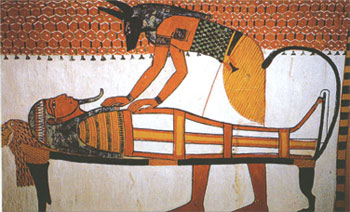
| |
The Egyptians' mummification techniques demonstrate that they possessed advanced medical knowledge.
|
The sophistication achieved by physicians in Ancient Egypt is quite amazing. Findings obtained from excavations have amazed archaeologists, because no historian expected such a highly developed technology in a civilization that existed in the 3,000s BCE.
X-ray analysis of mummies has revealed that brain surgery was performed in Ancient Egypt. 43 What is more, these operations were carried out using highly professional techniques. When mummy skulls that underwent surgery are examined, it can be seen that the incisions of the surgery have been cut very neatly. Skull bones that have fused back together prove that the patients survived long after such operations. 44
Another example concerns various medicines. Giant strides were made in medicine in the 19th century due to the rapid progress made in experimental science, including the discovery of antibiotics. Yet the word "discovery" is not strictly accurate, because many of these techniques had already been known to the Ancient Egyptians.45
Some of the most important evidence of just how advanced the Egyptians were in science and anatomy lies in the mummies they left behind them. They used hundreds of different techniques in the process of mummification, which permits the bodies of living things to be preserved for thousands of years.
The mummification process is highly complex. First, the brain and some of the internal organs of the deceased were removed using special instruments. The next stage in the procedure involved dehydrating the body for 40 days with natron. (Natron is a mineral salt, primarily a mixture of sodium bicarbonate and sodium carbonate with small amounts of sodium chloride and sodium sulfate.) After the excessive body fluids were reduced, the body cavity was then stuffed with linen, sand or sawdust. The skin was anointed with special herbal preparations and then coated with liquid resin to further preserve it. Finally the body was carefully wrapped in linen bandages. 46
Mummification, carried out without damaging the shape of the body and by extracting all the deceased's internal organs, shows that those who performed it possessed a sufficient knowledge of anatomy to know the position of all the various organs.
Quite apart from the techniques of mummification, the Egyptians of 5,000 years ago enjoyed a wide range of other medical sophistication. For example:
-The priests involved in medicine in Egypt treated many diseases in their temples. Just as today, Egyptian doctors specialized in various fields of medicine. Every doctor, provided services in his own specialty.
-Doctors in Egypt were supervised by the state. If the patient failed to recover or died, the state would investigate the reasons why and determine whether the method of treatment employed by the doctor conformed to the rules. If any oversight was found to have taken place during treatment, the doctor was penalized within the framework of the law.
- Every temple possessed a well-equipped laboratory in which medicines were prepared and stored.
- The first steps in pharmacology, and the use of bandages and compresses, go back to Ancient Egyptian times. The Smith Papyrus (which is wholly concerned with medicine) describes how adhesive strips of linen—an ideal material for making bandages—were used to cover wounds.
- Archaeological findings have revealed a detailed picture of medical practices in Egypt. In addition, the names and titles of more than 100 doctors specializing in their own fields have been discovered.
- In reliefs on a wall of the temple at Kom Ombo, a box of surgical instruments is carved. This box contained metal shears, surgical knives, saws, probes, spatulas, small hooks and forceps.
- The techniques employed were numerous and varied. Breaks and fractures were set, splints employed and wounds closed with stitches. Fractures that healed after treatment with great success have been found in many mummies.
- Although no trace of surgical scars has been found in mummies, there are 13 references to wound suturing in the Smith Papyrus. This indicates that the Egyptians managed proper wound suturing, employing linen thread. The needles were in all probability made out of copper.
- Egyptian doctors were able to distinguish between sterile wounds and infected ones. They used a mixture of ibex fat, fir oil and crushed peas to clean infected wounds.
- Penicillin and antibiotics were discovered relatively recently. However, the Ancient Egyptians used the first organic versions of these and other different types of antibiotic, and wrote prescriptions suited to various types of disease. 47
Along with these major strides in medicine, excavations have also revealed that the Egyptians were very interested in such subjects as urban planning and architecture.
Advanced Metallurgy in Ancient Egypt
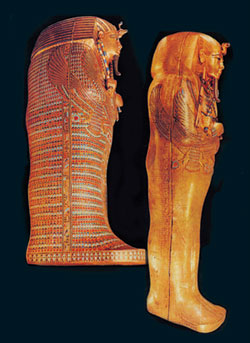
| |
The body of the Egyptian Pharaoh Tutankhamen was preserved inside two coffins, one inside the other.
|
In the general sense, metallurgy is the branch of science and technology involving the refining from raw materials, shaping and preservation of metals and their compounds. An examination of Ancient Egyptian civilization shows that between 3,000 and 3,500 years ago, the Egyptians had become expert at extracting and working various minerals and metals, especially gold, copper and iron. Their highly developed metallurgy shows that the Egyptians were advanced in finding, extracting and working ores, and had a highly developed knowledge of chemistry.
Archaeological research has revealed that the Egyptians were producing detailed work on copper ore and producing metallic compounds in around 3,400 BCE. In the Fourth Dynasty (around 2,900 BCE), mining research and operations were monitored by very high-ranking officials and are known to have been supervised by Pharaoh's sons.
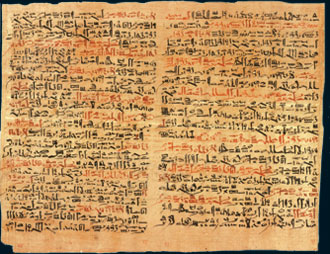
| |
The Smith Papyrus, which describes how the ancient Egyptians used bandages made out of linen.
|
In addition to copper, the Ancient Egyptians often used iron. Tin was used to create bronze, and cobalt to color glass. Metals not naturally occurring in Egypt were imported from other regions, particularly from Persia.
Their most frequently used and highly prized metal was gold. Hundreds of gold mines have been discovered in Egypt and parts of modern-day Sudan. One papyrus dating back to the 14th century BCE contains the plans of a gold mine near Apollinopolis, revealing the Ancient Egyptians' professionalism on the subject. The papyrus describes the construction of more than 1,300 dwellings around the mine just to accommodate those working in it. From this, the importance of goldsmithing and the art of jewelry in Ancient Egypt is apparent. Indeed, the hundreds of decorative golden objects discovered in archaeological excavations are indications that the Ancient Egyptians were expert miners and metalworkers.
This also goes to show that the Egyptians possessed the scientific knowledge and technology needed to identify seams of metal, extract ore from them, refine the metals thus extracted, and combine them to produce alloys.
Ancient Egyptian Urban Planning and Infrastructure
Egypt's arid climate has left behind many clues to their civilization, evidencing that ancient Egyptian cities had a highly developed infrastructure.
Stunning Pictures in The Chauvet Cave
|
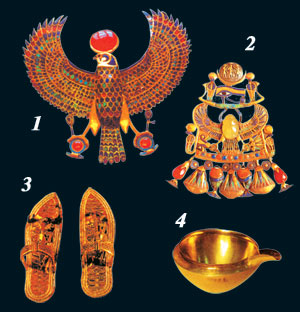
|
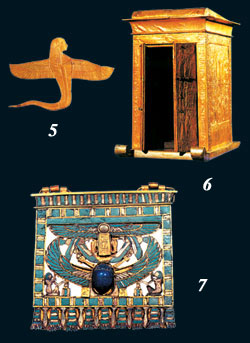
| |
(1)
(
2) Finely worked pectorals of the king, crafted of gold, silver and semi-precious stones
(3) A pair of finely crafted sandals
(4) A small, long-spouted pitcher made of hard gold still maintains its strength and brightness.
|
(5) This golden ornament found at the neck of Tutankhamen's mummy contains very fine gold workmanship; around 150 other jewels were found on the same mummy.
(6) A gold-plated wooden chest set on a silver-plated sledge
(7) A pectoral made of gold, lapis lazuli and turquoise, discovered at Tanis
| |
The fine workmanship in the jewels shows that sophisticated goldsmith's tools were employed. In the absence of such equipment, such fine workmanship is impossible. The quality and delicacy of Egyptian gold workmanship is equal to that of the present day.
|
Certainly a highly developed infrastructure shows that those who built these cities had an advanced knowledge of architecture and engineering.How far down underground foundations need to be dug, where the supporting beams need to be placed, how an effective ventilation system needs to be planned, the arrangement of pathways for clean and dirty water so they do not mix, and a great many other details must be considered. And, most important of all, no errors can be made in any of them. The Egyptians knew all these techniques, and the buildings they left behind prove this.
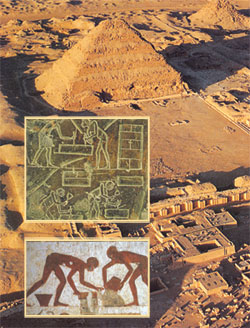
| |
One indication of the Egyptians' advanced civilization is doubtless their knowledge of architecture and engineering.
|
The architectural techniques they used in the 3,000s BCE were exceedingly professional and intended to resolve difficulties and problems of infrastructure. Water is of great importance to an arid country like Egypt. In fact, they found permanent solutions to the problem, including the tanks they built in which to store water.
A large reserve of water discovered in the Fayum oasis depression is one of these. The Egyptians also built some artificial lakes to ensure that life could continue in specific regions. These small lakes collected water from the Nile, making possible an advanced civilization in the Egyptian desert. They constructed Lake Moeris, 80 kilometers (50 miles) southwest of present-day Cairo, for the purpose of storing water from the River Nile by means of a canal. Settlements and temples were constructed near this reservoir. 48
The Egyptians' knowledge of medicine, urban planning, and engineering and how it should be put into practice are just some of the evidence of the exceptionally advanced civilization that they possessed. Their knowledge and the measures they implemented once again refute the thesis that societies progress from a primitive state to a civilized one. A society that existed 5,000 years ago possessed a more advanced level of civilization than some communities living in the same country today, something that cannot be explained in terms of "evolutionary progress." There's also no doubt that during the time when the Egyptians were enjoying their advanced civilization, there were more backward communities with people living under more primitive conditions in Africa and other parts of the world. Yet none of these individuals had any features that were less than human, nor any supposedly ape-like traits. The Egyptians, other people living in primitive conditions at the same period, as well as them and human communities that existed hundreds of thousands of years ago, have all been as entirely human as present-day Man, in all respects. Some communities may have lived in more advanced conditions and others in more backward ones, but this does not show, as Darwinists maintain, that they are descended from apes or that one race evolved from another. Such an interpretation is a violation of science, reason and logic.
Ancient Egyptians' Achievements in Textiles

| |
Examples of linen, dating back to Ancient Egypt
|
It can be seen from fragments of linen cloth that have survived from 2,500 BCE that the Egyptians produced very high-quality fabrics, in terms of both materials and weaving. Most important of all, however, are the details in the weaving of the cloth. In 2,500 BCE, the Ancient Egyptians were producing delicate fibers of the kind that are made today in machinery equipped with advanced technology, which linen was used for wrapping around mummies. The delicate weaving of these fabrics has amazed Egyptologists. 49 These specimens are so fine that one needs a magnifying glass to distinguish them from silk, and this fabric is comparable with the best work of the present-day machine loom. 50 Even today these fabrics are renowned for their quality, and the Egyptian linen made today owes its fame to the weavers who lived in the 2,000s BCE.
An Advanced Level of Mathematics
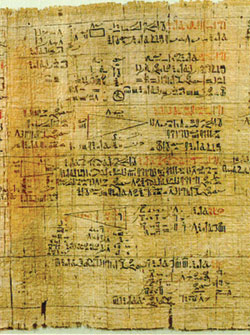
| |
The Rhind Papyrus
|
Numbers were used in Ancient Egypt from very early times. Papyruses from 2,000 BCE describing mathematical problems have been found. The four most referred to documents are known as the Kahun fragments, and Berlin, Moscow and Rhind papyruses. These documents state, with examples, the bases on which measurements are made. The Egyptians knew that a triangle whose sides measure 3:4:5 is a right triangle, and made use of this knowledge (which is now called the Pythagoras Theorem) in their construction calculations. 51
In addition, the Egyptians knew the difference between planets and stars. They added the stars, some of which are very hard to see with the naked eye, to their studies of astronomy.
And since the Egyptians' lives were dependent on the Nile, they had to check its level during its annual floods. The ruler had a "Nilometer" made to measure the height of the river waters, and appointed officials for that purpose. 52
A Construction Technology Full of Secrets
The most important structures built in Ancient Egypt, at which visitors still gaze in wonder today, are the mysterious pyramids. The most magnificent of them is the Great Pyramid, regarded as the largest stone edifice constructed in the world to date. Historians and archaeologists since the time of Herodotus have put forward various theories as to how this pyramid was built. Some have maintained that slaves were used in its construction and have suggested several different possible techniques, from the ramp technique to a terraced pyramid. The complete picture that emerges from these hypothetical methods is this:
-Had this pyramid been built by slaves, then their number would be extraordinarily high, in the range of 240,000.
-Had a ramp been built to construct the pyramid, then it would have taken some eight years to dismantle this ramp after the pyramid was completed. This theory, according to the Danish civil engineer Garde-Hanson, is ridiculous, because once the ramp had been torn down, giant rough blocks would have been left over. Yet no such evidence is to be seen anywhere. 53
Stating that Garde-Hanson has considered aspects underestimated by other theoreticians, Moustafa Gadalla, in his book Historical Deception: The Untold Story of Ancient Egypt, goes on to say:
Try to visualize the staggering figures as you visit the pyramid: 4,000 year-round quarrymen producing 330 blocks per day. During inundation season, 4,000 blocks per day are transported to the Nile, ferried across, hauled up the ramp to the Giza plateau, and set into place in the core—a rate of 6.67 blocks per minute! Imagine 6.67 blocks every 60 seconds! 54
-In addition, bear in mind the fact that the surface area of each pyramid face is some 5.5 acres. Then some 115,000 casing stones were needed for each surface. These stones have been so scrupulously laid in place that the gaps between them are too small to permit even a piece of paper to fit between them. 55
These are just some of the objections that show that the secrets regarding the construction of the pyramids have still not been resolved by the twenty-first-century science and technology.
Striking Facts About The Giza Pyramids
| |
Some of the research onto the pyramids at Giza has shown that the Ancient Egyptians possessed a highly developed knowledge of mathematics and geometry. In addition to their knowledge of mathematics and geometry, the people who planned the pyramids must also have known the measurements of the Earth, its circumference, and the angle of tilt of its axis. This information about the pyramids, whose construction began around 2,500 BCE, is even more striking when one considers that they were built some 2,000 years before the great Greek mathematicians Pythagoras, Archimedes and Euclid:
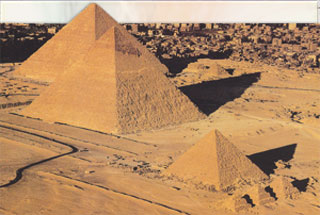
|
- The angles of the Great Pyramid divide the Nile delta region into two equal halves.
- The three pyramids of Giza have been arranged so as to form a Pythagorean triangle, whose sides have the proportions 3:4:5.
- The proportion between the height of the pyramid and its circumference is equal to that between the radius of a circle and its circumference.
- The Great Pyramid is a giant sundial. The shadows it casts between mid-October and the beginning of March reflect the seasons and the length of the year. The length of the stone slabs around the pyramid is equivalent to the length of one day's shadow.
- The normal length of the square base of the pyramid is equal to 365.342 Egyptian yards (a unit of measurement of the time). This is very close to the number of days in a solar year (which has been calculated at 365.224 days).
- The distance between the Great Pyramid and the center of the Earth is equivalent to that between the pyramid and the North Pole.
- In the pyramid, the perimeter of the base divided by twice its height is the number Pi.
The total surface area of the pyramid's four sides is equal to the square of its height. 56
|
If One Wished to Rebuild the Pyramids ...
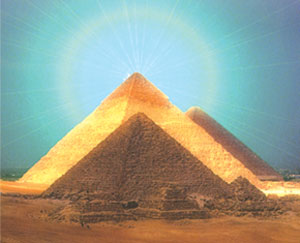
| |
The Great Pyramid of Cheops (Khufu)consists of some 2.5 million stone blocks. Assume that ten blocks were laid every day—which would require an enormous effort on the part of the workers—then it would take 684 years to lay all 2.5 million blocks. Yet it is thought that such pyramids in question took an average of only 20 to 30 years to build. Just this simple calculation reveals that when constructing the pyramids, the Egyptians used a very different and superior technology.
|
In 1978, the Indiana Limestone Institute of America, Inc.—one of the world's leading authorities on limestone—carried out a thought-provoking feasibility study to learn what size workforce and what kind of materials would be needed to build a pyramid similar to the Great Pyramid of Giza. The company officials described the difficulty involved, noting that if they tripled present-day average production, quarrying, fabricating and shipping such a quantity of limestone would take approximately 27 years. In addition, all this work would be done using modern American technology—in other words, hydraulic hammers and electrical crystal-headed saws. Enormous effort would be needed just to quarry and transport the limestone, not including the laboratory tests necessary for the building of the Pyramid, nor any other such preparatory work. 57
So how did the Ancient Egyptians build these giant pyramids? By what power, with what machinery, by what techniques were the rock terraces set out? By what means were the rock tombs carved out? How was lighting provided during construction? (No staining or soot has been found on the walls or ceilings inside the pyramids and tombs.) How were blocks of stone removed from the quarries, and how were the differently shaped faces of the blocks smoothed? How were these blocks, weighing several tons, transported, and how were they fit together to an accuracy of 1/1000 of a centimeter? The list of questions could be a lot longer. Can they be answered in a logical and rational way through the evolutionist misconception of mankind's history? Of course not!
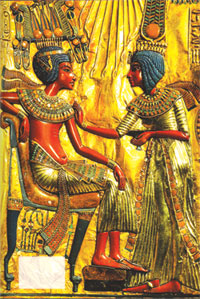
| |
Detail of the back-panel of Tutankhamen's royal throne, Cairo, Egyptian Museum
|
With their art, medicine and culture, the Ancient Egyptians produced a giant civilization. The works they left behind, the medical therapies they used and the accumulated knowledge and experience they possessed are some of the most important proofs of this. Some scientists today even claim that the works produced by the Egyptians—for whom, according to the evolution of history thesis, the building of pyramids must have been exceedingly difficult—were actually made by extraterrestrial visitors.
Of course, any such claim is exceptionally irrational and illogical. Yet evolutionists hide behind it since all their demagoguery is unable to provide a better explanation. First and foremost, there is not the slightest evidence to support their claim. When evolutionists realize that they cannot produce any explanation based on chance or imaginary evolutionary process, they immediately hide behind the idea of "visitors from space." Indeed, they came up with this ridiculous idea when they realized that the DNA in the cell nucleus and the first protein, representing the fundamental building block of life, had far too complex and extraordinary structures to have arisen by chance from inanimate substances. And so, visitors from space must have brought the first living organism to the Earth and left it behind. This ridiculous claim is one of the telltale signs of the despairing position evolutionists find themselves in.
The civilization in ancient Egypt—and all the other civilizations down through history—were all founded by people possessed of reason and will. Today, we are amazed by artifacts dating back to 3,000 BCE, and scientists and experts in the field debate how these could have been created. But what really matters is that the civilization of 5,000 years ago, whose traces can be seen today, was obviously built with an experience and sophisticated knowledge accumulated over thousands of years. In other words, the roots of this ancient civilization go back even further. That means that in the very earliest times there were no primitive, half-animal humans lacking the power of speech, and living solely by hunting, as is claimed by proponents of the evolution of history. Ever since the first human was created, Man has enjoyed the same human characteristics such as intelligence, conception of beauty, understanding, consciousness and moral values, as does Man today.

| |
1. Probable model of a backhoe of the period
|
2. Model of a present-day backhoe
|
|
Buildings constructed by past societies using giant stones indicate that machinery similar to that used in modern construction must have been employed in the past. The resemblance of this decorative object of gold to construction machinery is striking. Discovered in Panama in the 1920s, this item is believed to have been hung as a pendant. This and similar discoveries refute evolutionist claims that past societies were completely primitive. There have been obvious advances in technology and knowledge accumulated throughout the course of history, but this does not mean that people in the past lived like animals. Past societies developed various devices and used machinery in light of their own requirements.
|
A Model Glider in Ancient Egyptian Tombs
| |
Remains left behind by many civilizations indicate that air transport was used in very ancient times. This can clearly be seen in Mayan ruins, pictures in the Egyptian pyramids, and Sumerian inscriptions. As far as we can tell, people were building and using vehicles similar to gliders, airplanes, and helicopters thousands of years ago.
In fact, the Qur'an indicates that air transport may have been used long ago:
And We gave Solomon power over the wind—a month's journey in the morning and a month in the afternoon. (Qur'an, 34:12)
|
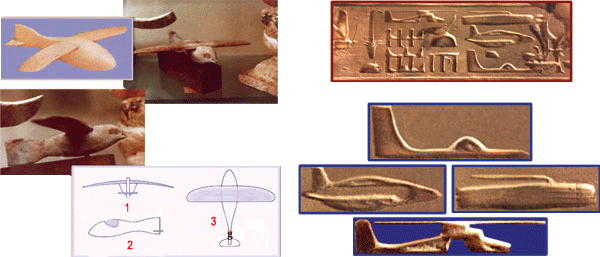
| |
A model glider estimated to date back to 200 BCE
1. Viewed from behind
2. Viewed from the side
3. Viewed from above
|
The devices seen here, discovered on the wall of the Abydios Temple by Dr. Ruth Hiver, are fascinating in their similarity to today's helicopters and jets.
|
|
It is very likely that the long distances referred to in this verse could have been traveled quickly in Prophet Solomon's (pbuh) day. This transportation may have taken place by means of wind-powered vehicles using a technology similar to that found in planes today. (God knows the truth.)
One piece of evidence that past civilizations employed air transportation is a model glider found in Egypt. This model, discovered in 1898, has been dated at about 200 BCE. Of course, finding a model glider some 2,200 years old is a rather remarkable event. This archaeological finding completely undermines the evolutionist conception of history. An even more interesting picture emerges when the model's technical features are examined. The shape and proportions of this wooden model's wings were designed in such a way as to give the aircraft a maximum lift with a minimum loss of speed, as in the Concorde, the product of today's most advanced technology. This also shows that the ancient Egyptians had a very good knowledge of aerodynamics.
|
A Solid Gold Model of an Aeroplane Found in Nazca
| |
Remains of aircraft belonging to past civilizations have been found not only in Egypt. The aircraft model pictured here was discovered in a cave in Colombia, South America. Thought to be more than 1,000 years old, it is now in the Smithsonian Institution in Washington, D.C.
The aerodynamic structure of this tiny model, with the projections on the edges of the rudder on the tail section, is no different from that of modern aircraft. In his book, The Puzzle of Ancient Man, Donald E. Chittick interprets this gold model in these words:
Of course, it is possible to propose another explanation for this discovery apart from advanced technology. But, when all these hand-made discoveries are put together and their meaning carefully assessed, only one explanation is possible: these remains belong to civilizations with advanced technology.*
* Donald E. Chittick, The Puzzle of Ancient Man, S. 109-110
|
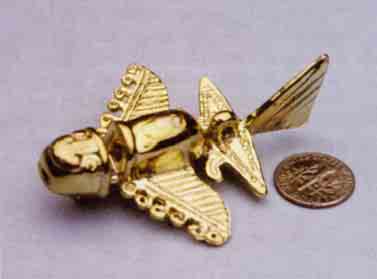
|
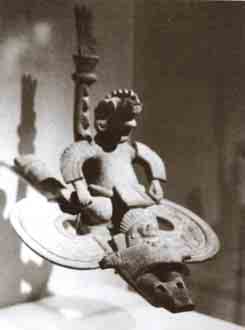
|
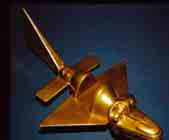
|
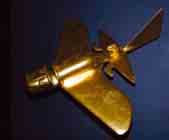
|

|
|
This statue found in Vera Cruz, dating from 200 CE, has been compared by researchers to a hovercraft--a present-day vehicle that can travel on both land and water. The rotors on the sides can revolve in a circular motion, and the tail functions as a rudder. There is even a section for exhaust emission, and a control panel. The uniform that the pilot is wearing completes this comparison.
|
Do "Dogus" Represent Pilots Who Lived Thousands Of Years Ago?
| |
Dogus are clay statues ranging between 7 and 30 centimeters (2.8 to 12 in) in height. So far, 3,000 of these statues have been found which are thought to have been crafted between 300 and 10,000 BCE. This makes them older than all former civilizations, including Egypt and Sumeria. Dogus were made by the Jomon people, which are thought to be the oldest known inhabitants of Japan. According to historical records, the Jomon were the first civilization to use ceramics.* In the Fukui Cave in Kyushu was discovered a piece of ceramic that is 12,700 years old.
Dogu figurines are very different from those of other past civilizations. When we look at them carefully, their clothing seems to have a variety of technical components resembling those of suits worn by pilots and deep-sea divers in the first quarter of the 20th century. The armor on Dogu figures is apparently articulated in various places to allow movement. There are openings to allow for breathing. The eyes are protected by special goggles. The hands are covered by removable gloves. The helmets have an especially interesting design: They are round, with a breathing mechanism that includes air hoses and headphones.
*The six thousand year old space suit, Vaughn M. Greene, foreword by Zecharia Sitchin
|

| |
These figures, which are remarkable for their resemblance with the 20th-century flight suits and diving suits, suggest that peoples of past times had a highly advanced technology. These discoveries indicate that there has been no such thing as any process of evolution over the course of history.
In the Qur'an God states that civilization in the time of Prophet Solomon (pbuh) had a very advanced level of air transport and underwater diving. (God knows best.) Here are two verses that indicate that the jinn serving Prophet Solomon (pbuh) were divers:
So We subjected the wind to him to blow at his command, softly, wherever he directed. And the demons, every builder and diver . . . (Surah Sad : 36-37)
|
A Two-Thousand-Year-Old Analog Computer: A Discovery To Confound The Evolutionists' Scenario
| |
In the year 1900, in one of modern archaeology's first major underwater finds, a sunken ship was discovered at the western entrance to the Aegean Sea between the islands of Crete and Kythera. The ship had been loaded full of figurines and amphorae, now in fragments.
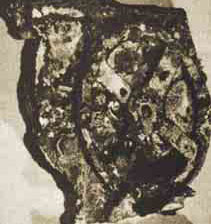
| |
Pictured here is the geared wheel recovered from the Aegean Sea and determined to be part of an ancient computer.
|
Most of the remains were determined to be the works of Greek artists of the early pre-Christian period. But among them was a calcified bronze fragment whose purpose was unknown. But after years of research, it was discovered that this mysterious artifact was an amazingly complex scientific device.
As this interesting device slowly dried out, its old wooden case and inner parts cracked, revealing four flat parts. On the inner side of a geared wheel was an inscription that proved very difficult to decipher. Scientists suggested that this was a navigating instrument. There have been many ideas put forward about this object but no clear conclusions. Speculations about it continued until the investigations in 1951 by Yale professor Derek J. de Solla Price.
In order to reconstruct the device, Price and his Greek colleagues investigated it by bombarding it with X-rays and gamma rays. Inside, they discovered layers of gears of various sizes arranged one above another. After long calculations of the probable original proportions of the gears, Price came to a stunning conclusion: The ancient Greeks had designed a mechanism to reproduce the actual movements of the sun, moon and planets in their past, present and future. This "Antikythera" mechanism was a 2,000-year-old analog computer. 1
This discovery confounded the claims of evolutionists that only rudimentary mechanisms were invented and utilized before the Hellenistic period.
The mechanism had originally been a bronze mechanism inside a rectangular wooden box. In front and at the rear were bronze doors on which the craftsman-inventor had inscribed detailed information. To read the information generated by the device, there were three dials. The first contained two scales, one of which displayed the signs of the Zodiac; the other was inscribed with the Greek names for the months of the year.
*The first dial showed the position of the Sun on every day of the year as it moved throughout the Zodiac.
* The second dial showed the eighteen-year cycle of solar eclipses.
* The third dial depicted the various phases of the moon.
An input was provided by a handle that needed to be turned once a day to turn a wheel of some thirty-nine bronze gears, which were meshed on parallel planes. This moved a driving-wheel that was attached with two trains of gears that were connected through a toothed turntable. The turntable acted as a differential gear train and when the input handle was turned, the two shafts rotated at different speeds. The differential gears, now used in modern-day automobiles that provide the tires to revolve at different rates of speeds on curves, were invented only in the 17th century. Price called the device one of "the greatest basis mechanical inventions of all time." 2
This discovery caused a major repercussion around the world. With it, the evolutionists' fictitious schema of "technological evolution" was upended. According to evolutionists, any civilization 2,000 years old ought to have no sophisticated technology and have used only simple tools. However, this device invented by ancient Greek mechanics showed that civilizations of the past were not as evolutionists imagine. They produced a celestial computer centuries ago and were more advanced than many medieval civilizations. (The first analog computer was developed in 1931 by Vannevar Bush.)3 In his book, The Puzzle of Ancient Man: Advanced Technology in Past Civilizations?, Donald E. Chittick makes this comment:
Even more surprising perhaps is the discovery of an object located on a ship that was sunk in the Aegean Sea before the time of Christ. It appeared to be some type of mechanical computing device. Modern computers are of two types: analog and digital. The object discovered on this ship sunk before Christ's time was a fairly sophisticated analog computer. 4
Of this discovery, an article in The Observer written by Helena Smith bore a headline announcing: "Revealed: World's Oldest Computer." The following extract is taken from her article:
… after the discovery of the calcium-encrusted bronze mechanism on the ocean floor, hidden inscriptions show that it is the world's oldest computer, used to map the motions of the sun, moon and planets. 'We're very close to unlocking the secrets,' says Xenophon Moussas, an astrophysicist with a Anglo-Greek team researching the device. 'It's like a puzzle concerning astronomical and mathematical knowledge.'... Michael Wright, a former curator at London's Science Museum … said the apparatus was the best proof yet of how technologically advanced the ancients were. 'The skill with which it was made shows a level of instrument-making not surpassed until the Renaissance.'
… many experts say it could change how the history of science is written. 'In many ways, it was the first analogue computer,' said Professor Theodosios Tassios of the National Technical University of Athens. 'It will change the way we look at the ancients' technological achievements.' 5
These statements by experts are very significant, because it took approximately 20 centuries before human beings could build a computer similar to the Antikythera mechanism. 2,000 years ago, Greeks had the knowledge to build an analog computer. All this shows us that people who lived so long ago had a higher level of civilization than many later societies—a fact that cannot be explained by evolution.
Certainly, there were backward civilizations in various places in the world while the Greeks were enjoying their own advanced civilization. The fact that some societies existed in an advanced civilization while some others were less-developed, does not indicate that mankind is a species that evolved from apes or that one society developed from another, as the Darwinists claim. This is an uninformed interpretation that goes against all science and logic.
|
Did Electricity Exist in Ancient Egypt?
| |
Reliefs in the temple of Hathor at Dendera have revealed the possibility that the Ancient Egyptians knew about and used electricity. When the figures in this relief are carefully examined, you can see that, just like today, high-voltage insulation must have been used at that time: A bulb-like shape is supported by a rectangular pillar (called the Djed pillar and assumed to be an insulator). This resemblance between the shape in the picture and electric lamps is astonishing. 58 While analyzing ancient Egyptian metal objects in 1933, Dr. Colin G. Fink—who invented the tungsten filament electric light bulb—found that the Egyptians knew a method of plating antimony on copper over 4,300 years ago. This was a method by which the same results accomplished today by electroplating were achieved. 59
Scientists have experimented with the system depicted in the reliefs to determine whether it could have emitted light. The Austrian electrical engineer Walter Garn studied the reliefs in great detail, and reproduced the Djed pillar insulator, bulb and twisting wire. The model he built did indeed work and emit light. 60
One piece of evidence that Ancient Egyptians may have used electricity is the absence of any traces of soot on the interior walls of their tombs and pyramids. If—as evolutionist archaeologists maintain—they used burning torches and oil lamps for lighting, then traces of soot would inevitably have been left behind. Yet there are no such traces anywhere, not even in the very deepest chambers. It would have been impossible for construction to continue without the necessary lighting being provided nor, even more importantly, for the magnificent murals to have been painted on the walls. This strengthens the possibility that electricity was, indeed, used in Ancient Egypt.
|
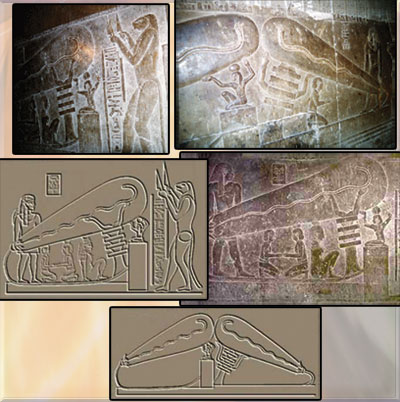
| |
The resemblance to today's light bulbs of the figures in these reliefs from the Temple of Hathor at Dendera has amazed scientists.
|
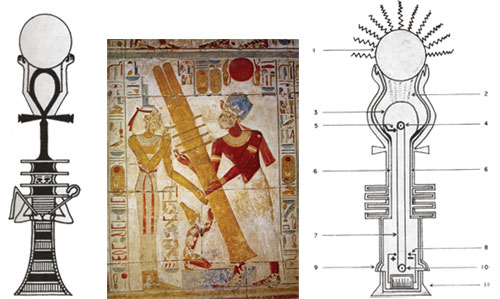
| |
The Djed pillar, frequently shown in Egyptian drawings, may symbolize a kind of electrical apparatus. The column may have served as a generator, thus providing lighting.
|
The Sumerian Civilization

| |
Phillip Johnson
|
In describing the supposed "evolutionary march" of the history of mankind, Darwinist scientists are quite helpless on another subject: Man's mind, by which mankind has built universities, hospitals, factories and states, composed music, held the Olympic Games and traveled into space—in short, one of the most important characteristics that makes Man what he is.
Evolutionists maintain that human mind assumed its present capacities by evolving after Man diverged from chimpanzees, our so-called closest living relative. They ascribe the alleged leaps that took place in the mind's evolution to random changes occurring in the brain, and to the improving effect of tool-making skills. You'll frequently encounter such claims in television documentaries and in articles in magazines and newspapers, telling tall tales concerning ape-men who first learned how to make knives out of stone, and then spears. But this propaganda is not valid. Although they attempt to portray the scenarios they set out as scientific, they are actually based solely upon Darwinist preconceptions, and completely unscientific. The most important point of all is that human mind cannot be reduced to matter. By documenting the invalidity of materialism, this fact alone totally undermines any claims regarding the evolution of mind.
Evolutionists maintain that mind emerged through evolution, but they have no means of experiencing what a primitive level of intelligence is like, nor of replicating the conditions in the supposed evolutionary process. Despite his being an evolutionist, Henry Gee, editor of Nature magazine, well known for its evolutionist content, openly admits the unscientific nature of such claims:
For example, the evolution of Man is said to have been driven by improvements in posture, brain size, and the coordination between hand and eye, which led to technological achievements such as fire, the manufacture of tools, and the use of language. But such scenarios are subjective. They can never be tested by experiment, and so they are unscientific. They rely for their currency not on scientific test, but on assertion and the authority of their presentation. 61
Besides being unscientific, such scenarios are also logically invalid. Evolutionists maintain that thanks to the intellect that supposedly emerged through evolution, the ability to use tools emerged and developed, thanks to which, in turn, intelligence developed. Yet such a development is possible only when human intelligence is already present. According to this account, the question of whether technology or mind first emerged through evolution goes unanswered.
Phillip Johnson, one of the most effective critics of Darwinism, writes this on the subject:
A theory that is the product of a mind can never adequately explain the mind that produced the theory. The story of the great scientific mind that discovers absolute truth is satisfying only so long as we accept the mind itself as a given. Once we try to explain the mind as a product of its own discoveries, we are in a hall of mirrors with no exit. 62
The fact that Darwinists are quite unable to account for their own human minds reveals that the claims they make about Man's cultural and social history are also invalid. Indeed, all the facts and findings we have reviewed so far makes Darwinists' claims regarding the "evolution of history" totally meaningless.
Contrary to what evolutionists claim, the history of mankind is full of proofs that ancient peoples possessed far superior technologies and civilizations than had been believed. One of these civilizations is that of the Sumerians. The artifacts they left behind are some of the proofs of the accumulated knowledge possessed by mankind thousands of years ago.
The Sumerians: An Advanced Civilization
Mesopotamia means "between rivers" in Greek. This region is one of the most fertile in the world, which has made it the cradle of great civilizations.
One group of people who emerged from south of these lands—from the region now known as Kuwait and northern Saudi Arabia—spoke a different language from other communities, lived in cities, were ruled by a monarchy based on a legal structure, and used writing. These were the Sumerians, who developed rapidly by founding great city-states from 3,000 BCE on, and brought great numbers of people under their sway. 63
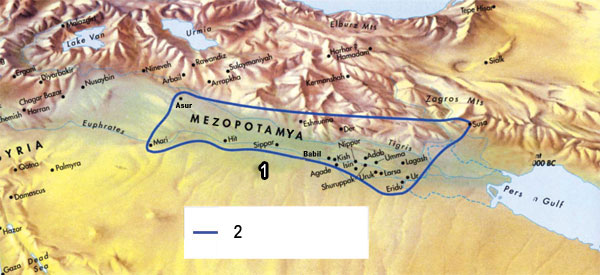
| |
1. Mesopotamia
|
2. The spread of Ancient Near Eastern People by 2000 BC. Sumerian Culture Area
|
|
From 3,000 BCE onward, the Sumerians brought large areas under their control by constantly founding large city-states.
|
At a later date, the Sumerians were defeated by the Akkadians and passed under their yoke. However, by adopting the Sumerians' culture, religion, art, law, state structure and literature, the Akkadians enabled civilization to preserve in Mesopotamia.
In their time, the Sumerians made significant developments in all fields, from technology to art and from law to literature. They had well-developed trade and a powerful economy. Bronze work, wheeled vehicles, sailing boats, statues and monumental structures are some of the evidence of their rapid progress that has survived to the present day. In addition, the Sumerians are known to have possessed many handcrafts that have not survived. The weaving and dyeing of wool—an important export commodity for Mesopotamian cities—can be cited as one of their developed lesser arts. 64
The Sumerians also had a developed social structure. Their state was a monarchical one, with the priest-king ruling with the help of a series of officials. After the harvest, these would share the produce among the people, and visit and inspect the fields. Bureaucracy formed the basis of the Sumerian administrative system. The priest in every region would assume responsibility for the people living there and thus ensure that food was equitably distributed, in big cities especially. Work carried out by the priests was recorded and archived.
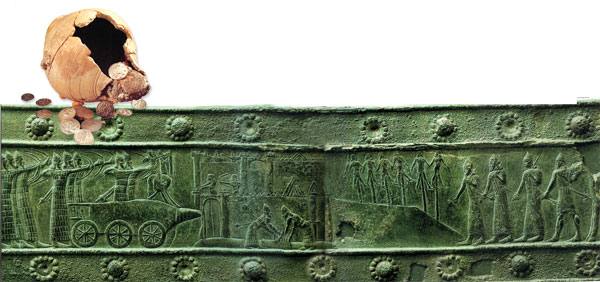
| |
The deep-rooted civilizations founded by ancient societies show that Darwin's thesis of "progress from the primitive to the civilized" does not reflect the facts. Sumerian civilization is one example of this. The way that the Assyrian chariot in the picture below moves with no propulsive force is worthy of note. The soldiers' armor shows how far advanced the craft of metallurgy was at that time. Their clothing is completely covered in armor, making it possible for them to move comfortably, while they are protected from head to foot. The chariot must be strong enough to stand up to wartime conditions and heavy blows, especially since it was used as a battering ram. The materials used and the chariot's strength are particularly striking. (2,000 BCE to 612 BCE)
|
In the social, artistic, scientific and economic spheres, the Sumerians, who lived some 5,000 years before our own time, are at total variance with the evolutionist model of Man supposedly advancing from the primitive to the developed. The great civilization built by the Sumerians was not only exceedingly advanced for its own time, but also considerably advanced in comparison to a great many societies of our day. This level of cultural development cannot be explained by evolutionist claims of human beings first ridding themselves of ape-like features, including communication in grunts, then beginning to socialize and raise animals, and only just learning about agriculture. It is clear that human beings have always been human, with all their intelligence, abilities and tastes, in all periods of history. The images of ape-men sitting by the fire in caves and spending their days making crude stone implements, as so frequently depicted by evolutionists, are entirely fictitious, and conflict with all historical, archaeological and scientific evidence.
Sumerian Science

|
The Sumerians used a 12-month calendar, drew maps of many constellations, and followed the movements of planets such as Mercury, Venus and Jupiter. The accuracy of their calculations has been confirmed by discoveries and computer calculations made in our time.
Based on their observations, the Sumerians thought that our Solar System was made up of twelve planets, counting the Sun and Moon. Their 12th planet, referred to as Nibiru in some sources, is actually the tenth planet, also known as Planet X whose existence many scientists have recently accepted.
The picture below shows Sumerian drawings of the Solar System. The Sun appears in the middle, with the planets orbiting around it.
|
|
A. Asteroid Belt
B. The Inner Planets
C. The Outer Planets
| |
1. The Sun
2. Mercury
3. Venus
4. The Earth
5. The Moon
6. Mars
|
7. Jupiter
8. Saturn
9. Uranus
10. Neptun
11. Pluto
12. Nibiru
|
The Sumerians had their own number system. Instead of the present-day base-10 system (decimal), they constructed a mathematical system based on the number 60 (sexagesimal). Their system still occupies an important place in our own day, in the way that we have 60 minutes in an hour, and 60 seconds in a minute, and 360 degrees in a circle. For these reasons, the Sumerians, whose mathematical knowledge produced the first geometrical and algebraic formulae, are regarded as the founders of modern mathematics.
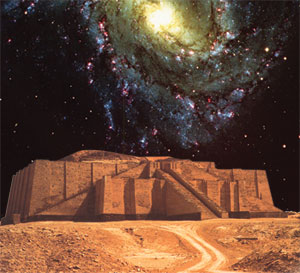
| |
Ziggurat
|
In addition, the Sumerians attained a rather advanced level in astronomy, and their calculations of the years, months and days were almost exactly the same as ours. The Sumerian calendar, with its year consisting of 12 months, was also used by the Ancient Egyptians, the Greeks and a number of Semitic societies. According to this calendar, a year consisted of two seasons—summer and winter. Summer began on the vernal equinox, and winter on the autumnal equinox.
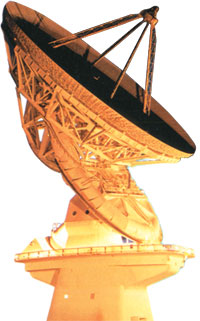
|
The Sumerians also studied the heavens from towers they referred to as "ziggurats." 65 They were able to predict solar and lunar eclipses, as can be seen clearly in a number of records. To record their astronomical discoveries, the Sumerians made charts of a great many constellations of stars. In addition to the Sun and Moon, they also studied and noted the movements of Mercury, Venus, Mars, Jupiter and Saturn. The calculations that the Sumerians produced 5,000 years ago have now been confirmed by the images sent back to Earth by spacecraft.
No doubt this is in complete conflict with claims of the evolution of history. We are looking at information originally discovered 5,000 years ago, which we have reacquired only recently thanks to giant telescopes, advanced computers and technology of various kinds. That being the case, evolutionist scientists should set aside their preconceptions and act in the light of the scientific and historical facts. That truth shows the invalidity of the idea, advocated by Darwinists, that civilizations always progress from the primitive to the more advanced. A number of ideological concerns underlie the attempt to account for the history of Man—who founds civilizations, composes music, produces works of art, constructs impressive buildings, explores space and makes scientific and technological discoveries—in terms of a supposed process of evolution. The correct approach for scientists is to behave in the light of the facts determined by experiment, discovery and observation, not ideological concerns.
The kingdom of the heavens and Earth belongs to God.
God has power over all things.
(Qur'an, 3:189)
The Nimrud Lens
|

| |
A lens-like fragment dating back some 3,000 years has been described as an important discovery that "could rewrite the history of science." That history shows that humankind has possessed the same mind, abilities and tastes from the moment he came into being.
|
A discovery made by the archaeologist Sir John Layard in 1850 raised the question of who actually used the first lens? During a series of excavations in what is now Iraq, Layard discovered a piece of a lens dating back 3,000 years. Currently on display in the British Museum, this fragment shows that the first known lens was used in the days of the Assyrians. Professor Giovanni Pettinato of the University of Rome believes that this rock-crystal lens—which, according to him, is a major discovery shedding considerable light on the history of science—could also explain why the ancient Assyrians knew so much about astronomy, having discovered the planet Saturn and the rings around it. 66
To what use was this lens put? That answer may be debatable, but it's still obvious that not all bygone societies lived simple lives, as evolutionist scientists maintain. Past societies made use of science and technology, built deeply-rooted civilizations and enjoyed advanced life styles. Only limited information regarding their daily lives has come down to us today, but practically all we know shows that none of these societies ever underwent evolution.
God created the heavens and the Earth with truth. There is certainly a sign in that for the believers. (Qur'an, 29:44)
|

|
The Baghdad Battery
| |
In 1938, the German archaeologist Wilhelm König discovered a vase-like object now known as the "Baghdad Battery." But how was it concluded that this object, some 2,000 years old, was used as a battery? If it actually was used as a battery—which the research carried out certainly indicates—then all theories to the effect that civilization always progresses and that societies in the past lived under primitive conditions, will be totally demolished. This earthenware pot, sealed with asphalt or bitumen, contains a cylinder of copper. The bottom of this cylinder is covered with a copper disk. The asphalt stopper holds in place an iron rod, suspended down into the cylinder, without making any contact with it.
If the pot is filled with an electrolyte, a current-producing battery is the result. This phenomenon is known as an electrochemical reaction, and is not far different from the way that present-day batteries work. During experiments, between 1.5 and 2 volts of electricity was generated by some reconstructions based on the Baghdad Battery.
This raises a very important question: What was a battery used for 2,000 years ago? Since such a battery existed, obviously there must have been tools and devices that it powered. This once again shows that people living 2,000 years ago possessed far more advanced technology—and by extension, living standards—than was previously thought.
|

|
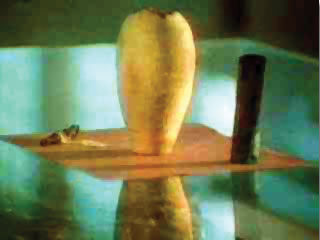
| |
1. Asphalt stopper
2. Copper cylinder
3. Iron rod
4. Electrolyte solution
| |
Research into this object, known as the "Baghdad battery" and dating back 2,000 years,
suggests that it was used as a battery to generate electricity.
|
The Mayans: Another Civilization That Refutes the Idea of the Evolution of History
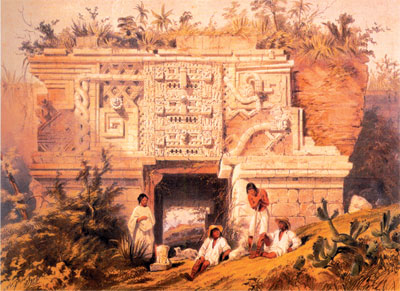
| |
Remains of a building in the Ancient Mayan city of Uxmal
| |
Some evolutionist scientists claim that the Mayans did not use metal tools. Yet if not, how can we account for the detailed stonework in Mayan ruins? Metal tools would swiftly oxidize and decay in the Yucatán rain forest, with its humid climate. It may well be, therefore, that Mayan metal objects have not survived down to the present. But their surviving stone structures show that it is impossible for such delicate and detailed work to have been produced using only stone tools.
|
Almost all evolutionist publications have one thing in common: All of them devote considerable space to imaginary scenarios regarding why some biological structure or characteristic of a living thing might have evolved. The striking factor is that all the stories evolutionists dream up are depicted as scientific fact. The fact is, however, that these accounts are nothing more than Darwinist fairy tales. Evolutionists seek to present the scenarios they come up with as scientific evidence. Yet these accounts are all entirely misleading, of no scientific worth, and can never constitute evidence for evolutionist claims.
One tale so frequently encountered in the evolutionist literature is that of allegedly ape-like creatures turning into human beings, and of primitive man gradually becoming a social entity. Despite there being no scientific evidence to support them, reconstructions of these supposed primitive human beings—in which they are depicted as walking only semi-upright, grunting, walking together with their "cave-families" or hunting with crude stone tools—are the best known parts of this scenario.
These reconstructions amount to an invitation to imagine and believe. With them, evolutionists seek to convince people not on the basis of concrete facts, but of fantastic speculation, because these are based on their authors' prejudices and preconceptions, rather than on scientific facts.

| |
El Mirador, Guatemala Reconstruction of a preclassic Mayan city
|
Evolutionists have no qualms about keeping these stories in the professional literature, nor about presenting them as if they were scientific truth, even though they are well aware of the erroneous nature of their accounts. However, these scenarios so frequently voiced by evolutionists constitute conjectures, not scientific evidence, for the theory of evolution, because there is no evidence that Man is descended from an ape-like ancestor. In the same way, no archaeological or historical evidence suggests that societies evolve from the primitive to the more advanced. Man has been Man ever since he first came into existence, and has created different civilizations and cultures in all periods of history. One of these civilizations is the Mayan, whose remains still inspire amazement today.
Historical sources refer to a tall figure in white robes who came to the communities living in this region. According to the information contained on monuments, the belief in a single God spread for a short time, while advances were made in science and art.
Have they not traveled in the Earth and seen the final fate of those before them? They had greater strength than them and cultivated the land and inhabited it in far greater numbers than they do. . . . (Qur'an, 30:9)

| |
Left top: Temple of the Warriors at Chichen Itza
Left bottom: Temple of Inscriptions, constructed during the reign of ruler Pacal
|
Right: Top part of the reconstructed Rosalila Temple
|
|
The detailed carving on the stone shows that the Mayans possessed the necessary technology for stonemasonry, which is next to impossible in the absence of tools such as steel files, chisels, and drills.
|
The Mayans: Expert Mathematicians
The Mayans lived in Central America in around 1,000 BCE, at a considerable distance from other advanced civilizations like those in Egypt, Greece and Mesopotamia. The most important features of the Mayans are the scientific advances they made in the fields of astronomy and mathematics, and their complex written language.
The Mayans' knowledge of time, astronomy and mathematics was a thousand years ahead of that of the Western world at the time. For example, their calculation of the Earth's annual cycle was a great deal more accurate than any other such calculations before the invention of the computer. The Mayans used the mathematical concept of zero a thousand years before its discovery by Western mathematicians, and used far more advanced figures and signs than their contemporaries.
The Mayan Calendar
The Haab, the civil calendar used by the Mayans, consisting of 365 days, is one of the products of their advanced civilization. Actually, they were aware that a year is slightly longer than 365 days; their estimate was 365.242036 days. In the Gregorian calendar in use today, a year consists of 365.2425 days. 67 As you can see, there's only a very small difference between the two figures—further evidence of the Mayans' expertise in the fields of mathematics and astronomy.
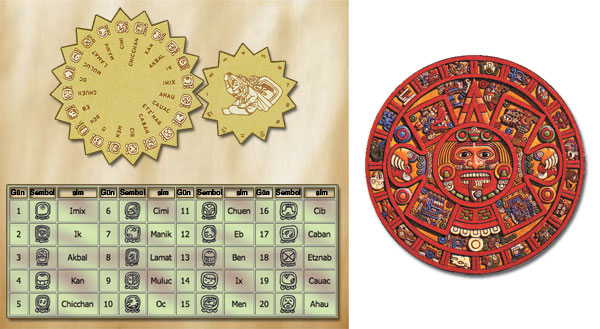
|
|
The Mayan calendar is almost identical to the 365- day Gregorian calendar used today. The Mayans calculated that a year was slightly longer than 365 days.
|
An Aztec calendar stone.
|
The Mayans' Knowledge of Astronomy

| |
Astronomical knowledge that can calculate the one day that needs to be subtracted from the orbit of Venus every 6,000 years is an important example of the advanced civilization of the past peoples.
|
Three books which have come down to us from the Mayans, known as the Maya Codices, contain important information concerning their lives and astronomical knowledge. Of the three—the Madrid Codex, the Paris Codex and the Dresden Codex—the latter is the most important in terms of showing the depth of the Mayan knowledge of astronomy. They possessed a very complex system of writing, of which only less than 30% has been deciphered. Yet even this is enough to show the advanced level of science they attained.
For example, page 11 of the Dresden Codex contains information about the planet Venus. The Mayans had calculated that the Venusian year lasted 583.92 days, and rounded it up to 584 days.
In addition, they produced drawings of the planet's cycle for thousands of years. Two other pages in the codex contain information about Mars, four are about Jupiter and its satellites, and eight pages are devoted to the Moon, Mercury and Saturn, setting out such complicated calculations as the orbits of these planets around the Sun, their relationships with one another, and their relationships with the Earth.
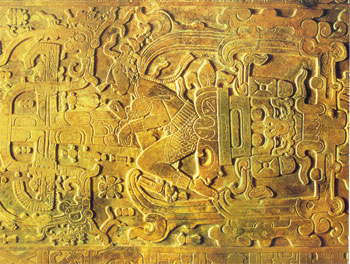
| |
Detail from the coffin cover of the tomb of the Mayan ruler Pacal.
|
So accurate was the Mayans' knowledge of astronomy that they were able to determine that one day needed to be subtracted from the Venusian orbit every 6,000 years. How did they acquire such information? That is still a matter of debate for astronomers, astro-physicists and archaeologists. Today, such complex calculations are made with the help of computer technology. Scientists learn about outer space in observatories equipped with all kinds of technical and electrical apparatus. Yet the Mayans acquired their knowledge centuries before the invention of present-day technology. This yet again invalidates the thesis that societies always progress from a primitive to a more advanced state. Many bygone societies had just as advanced a level of civilization as current ones, and sometimes even more so. Many communities today have not yet achieved the levels attained by societies in the past. In short, civilizations sometimes move forwards and at other times backwards, and both advanced and primitive civilizations sometimes exist at the very same time.
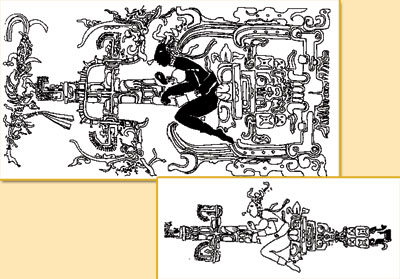
|
|
The vehicle Pacal is sitting on resembles a kind of motorbike, which may be a powered vehicle used at the time.
|
Network of Roads in the Ancient Mayan City of Tikal
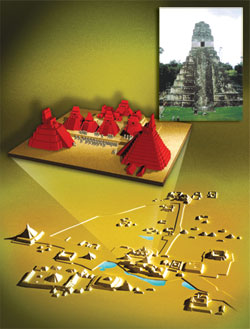
|
Darwinists maintain, despite possessing no scientific evidence, that ancient men were primitive beings living in a primitive manner, and that their intelligence developed over time.
Archaeological findings refute this, however. Excavations carried out in the Ancient Mayan city of Tikal, for instance, reveal a marvel of engineering and planning. Aerial photographs show that Mayan cities connected to one another by a wide network of roads. This all shows that advanced civilizations have existed in all periods of history.
|
Tikal, one of the oldest Mayan cities, was founded in the 8th century BCE. Archaeological excavations in the city, which stands in wild jungle, have unearthed houses, palaces, pyramids, temples and assembly areas. All these areas are connected to one another by roads. Radar images have shown that in addition to complete drainage system, the city also enjoyed a comprehensive irrigation system. Tikal stands neither by a river nor by a lake, and it was found that the city made use of some ten water reservoirs.
Five main roads lead from Tikal into the jungle. Archaeologists describe them as ceremonial roads. Aerial photographs show that Mayan cities were linked to one another by a large network of roads totaling some 300 kilometers (190 miles)in length and demonstrating detailed engineering. All the roads were made from broken rocks and were covered over with a light-color hard-wearing layer. These roads are perfectly straight, as if laid out with a ruler, and the important questions remain of how the Mayans were able to determine direction during the construction of these roads and what equipment and tools they used. The evolutionist mentality cannot provide rational and logical answers. Because we are dealing with a marvel of engineering, hundreds of kilometers long, it is crystal-clear that these roads are the product of detailed calculations and measurements and the use of the necessary materials and tools.
Cogs Used by the Mayans
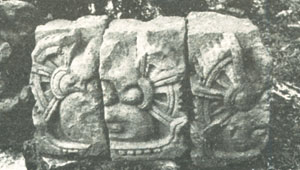
| |
Mayan cogwheels, in Copan
|
Research in regions inhabited by the Mayans shows that they used devices containing cogwheels.
The photograph overleaf, taken in the major Mayan city of Copan, is one of the proofs of this. A society using cogwheel technology must also possess a knowledge of mechanical engineering.
It is impossible for anyone lacking this knowledge to produce a cogwheel mechanism. For example, if you were asked to produce a similar mechanism to that in the photograph, then without the appropriate training you could not do so, nor ensure that the mechanism would function properly.
Yet that the Mayans managed to do this is an important indicator of their level of knowledge, and proves that those who lived in the past were not "backward," as evolutionists claim.
The examples up to now are only a few that demonstrate the advanced levels of civilization achieved by communities in the past. These point to one very significant truth: The evolutionist thesis imposed for so many years, that societies in the past lived simple, backward, primitive lives, is simply wrong. Societies with different levels of civilization and different cultures have existed in all ages; yet none evolved from any other. The fact that some backward civilizations existed 1,000 years ago does not mean that history itself evolved, or that societies progress from the primitive to the more advanced. Because alongside these backward communities, there were also highly advanced ones that made huge strides in science and technology and founded deep-rooted civilizations. Yes, cultural interaction and the accumulated knowledge handed down through generations may well play a role in societies' development. But this is not evolution.
In citing examples of the communities that lived in the past, the Qur'an tells us that some of these did indeed build advanced cultures:
Have they not traveled in the Earth and seen the final fate of those before them? They were greater than them in strength and left far deeper traces on the Earth . . . (Qur'an, 40:21)
Have they not traveled in the land and seen the final fate of those before them? They were more numerous than them and greater in strength and left more and deeper traces on Earth, but what they earned was of no use to them. (Qur'an, 40:82)
How many wrongdoing cities We destroyed, and now all their roofs and walls are fallen in; how many abandoned wells and stuccoed palaces! (Qur'an, 22:45)
These statements imparted in the Qur'an are supported by archaeological findings. When archaeological discoveries and the sites where past communities lived are examined, it can indeed be seen that most of these societies enjoyed a higher level than some present-day communities, and that they made enormous advances in the fields of construction technology, astronomy, mathematics and medicine. This yet again invalidates the Darwinist myth of the evolution of history and societies.

| |
Haven't they traveled in the land and seen the final fate of those before them? They were far greater than them in strength. God cannot be withstood in any way, either in the heavens or on Earth. He is All-Knowing, All-Powerful.
(Qur'an, 35:44)
|
The Still-Unsolved Nazca Lines
| |
The Nazca lines, outside of the Peruvian city of Lima, are one of the discoveries that scientists are unable to explain. These most astonishing lines were first revealed by studies from the air performed by Dr. Paul Kosok, from New York's Long Island University, in 1939. Kilometers long, these lines sometimes resemble an airport's runways, and also depict various birds, monkeys, and spiders. Who constructed these lines in an arid Peruvian desert, why, and how is still a mystery. On the other hand, whoever produced them obviously did not live primitive lives, as some scientists maintain. These lines, which are properly visible only from the air, were produced flawlessly, which is something quite extraordinary that calls for considerable reflection.
|
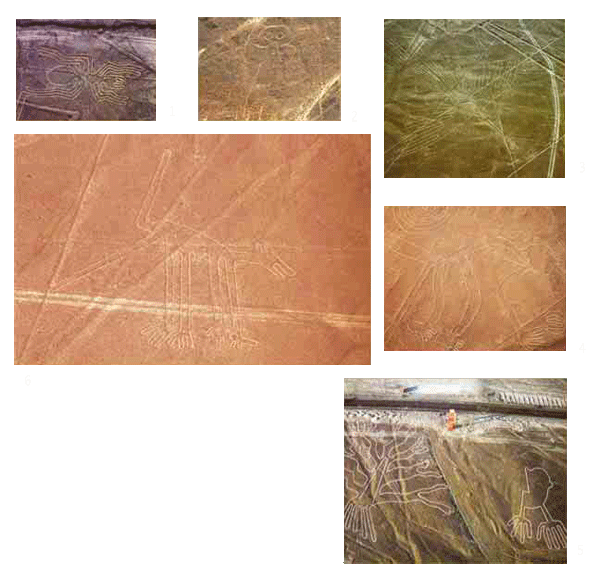
| |
1. A 45-meter-long (150-feet) spider image
2. A human figure
3. A 140-meter-long (450 feet) representation of a condor
|
4. A large image of a monkey, 58 meters (190 feet) wide and 93 meters (305 feet) long
5. A tree figure
6. A dog figure
|
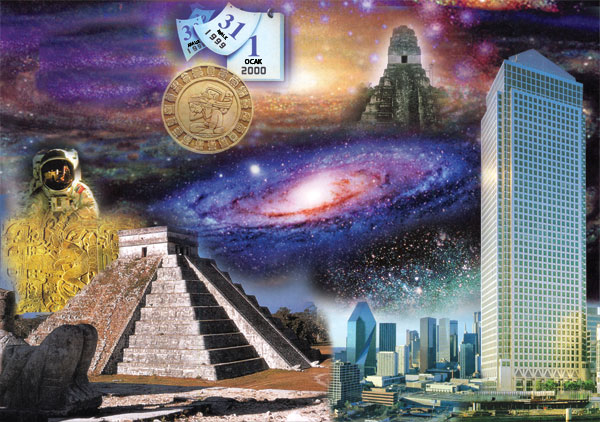
|
|
During the course of history, great advances have been made in all areas, along with enormous scientific and technological progress. But it is irrational and unscientific to describe these changes as "evolution," in the way that materialists do. Thanks to the accumulation of culture and knowledge, there is constant progress in such fields as science and technology. However, just as there is no physical difference between present-day humans and those who lived thousands of years ago, neither do they differ in terms of their intelligence and ability. The idea that 20th-century people possess more advanced civilizations because their brain capacity has grown is an erroneous perspective, a result of evolutionist propaganda.
|
The Impasse of Language Evolution

| |
There are many races in the world speaking many languages, and every language is
highly complex. Evolutionists cannot even imagine how such complexity might have
come about gradually.
|
In recounting the myth of the evolution of mankind's history, evolutionists encounter a number of serious problems. One is how human consciousness emerged in the first place. Another concerns the origin of speech—one characteristic that distinguishes human beings from all other living creatures.
When we speak, we are able to shape our thoughts thanks to language, and to express them in such a way that another party can understand them. Although this requires highly specialized muscular movements of the lips, throat and tongue, we are hardly aware of this. We merely "want" to speak. Sounds, syllables and words emerge through the harmonious contraction and relaxation of some 100 different muscles, and sentences comprehensible to others are formed by the appropriate sequences of such grammatical elements as subject, object and pronoun. The fact that we do nothing more than "wish" to use such an ability, based on such complex stages, clearly shows that speech is not merely an ability that arises from essential biological structures.
The human capacity for speech is an exceedingly complex phenomenon that cannot be explained in terms of the imaginary requirements or mechanisms of an evolutionary process. Despite lengthy research, evolutionists have been unable to produce any evidence that an exceedingly complex ability like speech evolved from simple animal-like sounds. David Premack from Pennsylvania University made this failure abundantly clear when he said, "Human language is an embarrassment for evolutionary theory . . ." 68

| |
Richard Dawkins
|
The well-known linguist Derek Bickerton summarizes the reasons for this "embarrassment:"
Could language have come directly out of some prehuman trait? No. Does it resemble forms of animal communication? No . . . no ape, despite intensive training, has yet acquired even the rudiments of syntax . . . how words emerged, how syntax emerged. But these problems lie at the heart of language evolution. 69
All languages on Earth are complex, and not even evolutionists are able to imagine how such complexity could have been acquired gradually. According to the evolutionist biologist Richard Dawkins, all languages—even the tribal ones regarded as most primitive—are highly complex:
My clear example is language. Nobody knows how it began . . . Equally obscure is the origin of semantics; of words and their meaning . . . all the thousands of languages in the world are very complex. I am biased towards thinking it was gradual, but it is not quite obvious that it had to be. Some people think it began suddenly, more or less invented by a single genius in a particular place at a particular time. 70
Two evolutionist brain researchers, W.K. Williams and J. Wakefield of Arizona State University, say this on the subject:
Despite the lack of evidence for intermediate stages in linguistic evolution, the alternatives are hard to accept. If some species-specific characteristic did not evolve in piecemeal fashion, then there would seem to be only two ways to explain its appearance. Either it was put in place by some still-undiscovered force, perhaps through divine intervention, or it was the result of some relatively abrupt change in the development of the species, perhaps some sort of spontaneous and widespread mutation . . . but the fortuitous nature of such a happenstance mutation makes that explanation seem suspect. As has been pointed out (Pinker and Bloom, 1990), the chances against a mutation resulting in a system as complex and apparently so ideally suited to its task as is language are staggeringly high. 71

| |
Noam Chomsky
|
Professor of linguistics Noam Chomsky comments on the complexity of the ability to speak:
I've said nothing so far about the production of language. The reason is that there is little to say of any interest. Apart from peripheral aspects, it remains largely a mystery. 72
To anyone not trapped inside evolutionist preconceptions, the origin of the capacity for speech is perfectly clear. It is Almighty God Who bestows this ability on Man. God inspires speech in human beings and causes them to speak, as is revealed in a verse from the Qur'an:
... They will reply, "God gave us speech as He has given speech to everything. He created you in the first place and you will be returned to Him." (Qur'an, 41:21)
In the same way that evolutionists are unable to account for the complexity of the biological structures that enable speech, they are also unable to explain the origin of the consciousness that makes language possible. Human consciousness and the complexities of language show that language was created by a superior Intelligence that belongs to Almighty God, our Lord.
|



